Kaupapataka
Open Agenda
|
Te Rā Hui:
Meeting date:
|
Friday, 26 March 2021
|
|
Te Wā:
Time:
|
10.30am
|
|
Te Wāhi:
Venue:
|
Council Chamber
Ground Floor
Civic Administration
Building
Lyndon Road East
Hastings
|
|
Te Hoapā:
Contact:
|
Democracy
and Governance Services
P: 06 871 5000
| E: democracy@hdc.govt.nz
|
|
Te Āpiha Matua:
Responsible Officer:
|
Waste
Planning Manager - Angela Atkins
|
Joint Waste
Futures Project Steering Committee – Terms of Reference
Background
Section 43 of the Waste Minimisation Act 2008 states that a
territorial authority must adopt a waste management and minimisation plan which
provides:
·
objectives, policies and methods for effective and efficient
waste management and minimisation,
·
collection, recovery, recycling, treatment and disposal services
·
facilities for waste management
·
waste minimisation activities including education and public
awareness; and
·
a framework for funding implementation, grants and advances of
money
The Solid Waste Management Committee which had been set up
with Napier City Council, jointly prepared a Waste Minimisation Plan (WMMP)
which was formally adopted in 2012. This committee was disestablished
upon adoption of the WMMP. In early 2014 the Joint Council Waste Futures
Project Steering Committee was established to meet to oversee and manage a
range of programmes and interventions to achieve effective and efficient waste
management and minimisation within the Omarunui landfill catchment.
The WMMP must be reviewed every 5 years. A Waste Assessment,
which is the first step of the review has been undertaken and options are being
developed for the WMMP. It is proposed that all submissions on the draft WMMP
are heard by a joint committee of Napier City and Hastings District Council:
Purpose
·
To approve the content of the Draft Waste Management and
Minimisation Plan for public consultation.
·
To hear submissions and make recommendations to the constituent
Councils on the draft regional Waste Management and Minimisation Plan
2011-2017.
·
To be responsible for overseeing, supporting, monitoring and
reporting progress toward achieving the intent of WMMP. As well as representing
the interests of participatory Councils in the WMMP.
·
To review the Joint Waste Management and Minimisation Plan at
least every six years to meet the requirements of the WMA 2008
Members
Three elected members appointed from Hastings District
Council
Three elected members appointed from Napier City Council
Name
The Joint Waste Futures Project Steering Committee
Status
By agreement of the local authority members, the Joint Waste
Futures Joint Project Steering Committee has been established as a Joint
Committee under clause 30A of Schedule 7 of the Local Government Act 2002.
Delegated Authority
The Joint Committee will have responsibility and authority
to:
1.
Accept and hear submissions on the joint Waste Management and
Minimisation Plan 2017-2023, and report back to the individual Councils on an
as required basis.
2.
To make recommendations to each participant Council on the Waste
Management and Minimisation Plan.
3.
To monitor performance and progress to give effect to the purpose of the
WMMP and to make recommendations to the constituent Councils accordingly.
Administering Authority and Servicing
Hastings District Council shall administer the Joint
Committee meetings.
Meetings
The Hastings District Council’s Standing Orders will
be used to conduct the Joint Committee meetings.
The Joint Committee shall meet as and when required as
agreed for the achievement of the purpose of the joint committee.
Quorum
The quorum at any meeting shall be not less than four (4)
including not less than two representatives of each of the member bodies.
Voting
The members shall strive at all times to reach a consensus.
Each representative shall be entitled to one vote at any
meeting.
There shall be no casting vote.
Chairperson and Deputy Chairperson
The Joint Committee shall also appoint by simple majority
vote, a Chairperson from one Council and a Deputy Chair from the other Council.
Variations
Any Member may propose an amendment (including additions or
deletions) to the Terms of Reference which may be agreed to by the Joint
Committee.
Variations to the Terms of Reference must be referred to the
constituent Councils for ratification.
Term of Office
The primary purpose of this Joint Committee is the approval
and adoption, by both Councils, of the Waste Management and Minimisation Plan
2018. However the Joint Committee will continue to meet as and when required to
oversee performance of the WMMP in operation.
Kaupapataka
Open Agenda
|
Group Members:
|
Heamana
Chair: Councillor Ann Redstone (HDC)
Deputy Chair: Councillor Api Tapine (NCC)
Councillors Damon Harvey and Sophie
Siers (HDC)
Councillors Annette Brosnan
and Richard McGrath (NCC)
|
|
Tokamatua:
Quorum:
|
4 members - at least 2
Councillors from each Council
|
|
Apiha Matua
Officer Responsible:
|
Waste Planning Manager – Angela
Atkins
|
|
Te Rōpū Manapori me te Kāwanatanga
Democracy & Governance Services
|
Lynne Cox (Extn 5632)
|
Te Rārangi Take
Order of Business
|
1.0
|
Apologies
& Leave of Absence
– Ngā Whakapāhatanga me te Wehenga ā-Hui
At the
close of the agenda no apologies had been received.
At the
close of the agenda no requests for leave of absence had been received.
|
|
|
2.0
|
Conflict
of Interest–
Mahi Kai Huanga
Members need to be vigilant to stand aside from
decision-making when a conflict arises between their role as a Member of the
Council and any private or other external interest they might have.
|
|
|
3.0
|
Confirmation
of Minutes - Te
Whakamana i Ngā Miniti
Minutes of the
Joint Waste Futures Project Steering Committee held Friday 4 December 2020.
(Previously circulated)
|
|
|
4.0
|
Events
Waste Minimisation Update
|
9
|
|
5.0
|
Treated
Timber Disposal Option with Pan Pac
|
13
|
|
6.0
|
Hastings
District Council - Waste Management and Minimisation Plan Implementation
Update
|
19
|
|
7.0
|
Local
Government Waste Manifesto - 2020
|
43
|
Hastings
District Council: Joint Waste Futures Project Steering Committee
Te Rārangi Take
Report to Joint Waste Futures Project Steering Committee
|
Nā:
From:
|
Cloe Vining, Waste
Minimisation Officer
|
|
Te Take:
Subject:
|
Events Waste
Minimisation Update
|
1.0 Purpose and summary - Te Kaupapa Me Te Whakarāpopototanga
1.1 The purpose of this
report is to update the committee of the intentions and methods that could be
implemented to minimise waste at events in the Hastings District. This
report relates to “Action L” of the Joint Waste Management and Minimisation
Plan (WMMP) 2018-2024.
1.2 The Hastings District
is coming alive with more events being hosted here each year. There are many
different types of events; including community events in the parks, concerts,
winery events, sporting events, street festivals, fairs, sector group events,
etc. Regardless of who is hosting the event, events appear to act as a de
facto representative of the town/region in which they are being hosted in.
1.3 The waste team has
little data on waste volumes produced from events locally, however external
estimates suggest that the typical event attendee produces 1.89kg of waste per
day. Apply that to an event with between 4,000 to 20,000 people and we have
significant amounts of waste (7.5 tonne to 37 tonnes) that with proper planning
and systems can easily be reduced and diverted to reuse.
1.4 A number of other
regions around the country such as Auckland, Tauranga, Nelson, New Plymouth and
Marlborough are seeing events choosing to be more waste conscious. Hastings has
not seen this same uptake as other regions from event planners and leaves room
for improvement.
1.5 Event waste is an
achievable waste stream that with some initial groundwork and support from the
waste minimisation team could see some tangible improvements in diversion
volumes that will reflect well on the Hastings District.
2.0 Event Waste Background
2.1 Minimising event waste
is unfortunately not as straight forward as providing different bins for
different types of waste and therefore reducing the amount that ends up in the
landfill bin.
2.2 When recycling and
organic waste bins are left unattended, despite users’ best intentions
and good signage, these bins will almost always end up being too contaminated
for the contents to be able to go to their originally intended destination.
2.3 To help combat these
issues it is essential that bin stations are manned with staff or volunteers to
help guide people to use the right bins. It is also important that food vendors
are using the right types of packaging for their food that can be recycled or
composted.
2.4 At bin stations there
is often a lot of confusion around what is compostable food packaging.
Currently food waste and compostable packaging collected commercially from
events is usually taken to BioRich for composting.
2.5 From July 2021 BioRich
will no longer by accepting any Polylactic Acid (PLA) containing materials
coming to their site as it effects their BioGro (organic) certification. PLA is
a material used to make many different types of compostable packaging, generally
the types that look like they are plastic. PLA is often used as liner of
cardboard packaging to make it water proof. This change can be confusing for a
lot of food vendors who have previously bought compostable packaging containing
PLA, thinking that they are doing the right thing.
2.6 Minimising event waste
can also go much further than having manned bin stations. Around the country we
are starting to see events avoid single use packaging completely and instead
opting for reusable crockery and having staff and volunteers run wash stations.
Also using the likes of rental cups from an external entity, where attendees
pay a small deposit for a reusable cup that is used throughout the event, which
can then be returned in exchange for their deposit back. Feedback suggests that
using these methods leaves a very good impressions on attendees. Attendees can
be encouraged to bring their own cup/container to events.
2.7 Knowing how to
implement staffed bin stations or opting for reusables can seem intimidating
for event organisers and something often left to the last minute to action, or
put in the too hard basket from the beginning.
3.0 Proposed event waste minimisation approach
3.1 The waste minimisation
team aim to have new materials and processes in place in time for the planning
of the 2021/22 summer event season to help event planners minimise event waste.
3.2 Event waste
requirements can be considered through the solid waste bylaw review
process. Many other Councils around NZ have included solid waste bylaws
requirements to reduce waste at events and submit event waste minimisation
plans for approval. The bylaw review process is likely to take approximately 1
year and will not be completed in time for the 21/22 event season.
3.3 To equip event
planners with the knowledge and tools to be able to minimise their event waste
and what options are available to them. The waste team are putting together an
‘Event Waste Guide’ based on guides made by other Councils with a
focus on Hawke’s Bay facilities and requirements. The guide will give
event planners the knowledge and tools to also submit a waste minimisation plan
to Council as outlined in 3.2.
3.4 The Event Waste Guide
will be available to event planners/organisers either in PDF format or hard
copy during their initial stages of contact with Council event staff to allow
them as much advanced planning time as possible.
3.5 The Environment Centre
Hawke’s Bay (EC), a not for profit organisation supported by HDC through
a contract for service, currently offer services for waste minimisation at
events. The EC are looking to shift this focus from offering overall waste
management services, to more of a waste minimisation at events coordinator or
facilitator service. This service would still assist event planners with overall
supervision, access to a pool of volunteers, and coordination with local waste
operators, however through this role the EC would aim to place more
responsibility on the event holder to provide sufficient staffing and
resourcing to carry out the waste minimisation aims. For larger events or for
events that would prefer to outsource waste planning, the EC services would be
available to ensure waste minimisation can still be achieved.
3.6 The waste team are
also putting together an ‘event packaging guide’ which will contain
a comprehensive list of packaging types and the companies in New Zealand that
provide compostable, PLA free food packaging. This will be available for event
planners and food vendors to reduce confusion around packaging and provide clear
guidance on the most suitable packaging types. It is expected that event
planners/organisers will place requirements on food vendors participating at
their event to only use certain types of packaging to assist with the
management and minimisation of waste. To coincide with the packaging guide a
packaging accreditation can be created that would include signage which vendors
could display advising customers that are using sustainable packaging.
3.7 Reusable cup schemes
such as rental cups will also be encouraged in the waste guide. Such schemes
could operate by charging attendees a small fee for the use of a reusable cup
and they are able to get a partial refund once they return their cup at the end
of the event. There are a number of ways that a reusable cup system can be set
up. This includes the incorporation of a branded cup in the ticket price that
can then be taken home as a keep sake.
3.8 The waste team are
looking at creating waste kits on trailers for community events to borrow to
help simplify their planning requirements. Event organisers would pay a deposit
that would be returned upon all the items being returned. It is likely that
there would be two different kits available.
- The
first kit would contain all the relevant equipment to be able to set up a waste
station at an event, and would include materials such as different colours
wheelie bins, signage, PPE gear, litter picks, liners, etc.
- The
second kit would contain the relevant equipment to be able to set up a wash
station for an event wanting to avoid single use materials and utilise
reusables. It would contain the likes of wash buckets, tables, PPE, a
steriliser, flags and signage, etc. The uptake for the second kit will likely
be lower and a bit slower than the first kit as this is more of a commitment
for events to take on than the first kit. By providing the equipment however
the waste team hopes that this will encourage event planners to consider the
next step.
3.9 It is difficult to
quantify the difference is in costs for events that minimise waste and those
that don’t. There would be clear costs saved from less disposal costs to
landfill which is generally the more expensive disposal option. For larger events
such as the recent Six60 concert a waste minimisation leader would need to be
employed to oversee the work, however this person would likely be required is
there were no waste minimisation aims also. If events are using reusable
schemes then food vendors are saving on packaging costs. Rental cup schemes can
be planned to be cost neutral by incorporating the expense in to other areas.
By setting up trailer kits the waste team hopes to be able to minimise any
additional costs especially for the likes of smaller free community events.
3.10 To also help with any potential
additional costs, using levy funds, the waste team is also looking to set up
funding options of various levels to event planners depending on the level of
waste minimisation that they are committing to. The levels of commitment could
be awarded as badges that are then used as a type of waste certification for
that event. Continued support and check-ups would be needed for event planners
to ensure that funds haven’t been granted then waste efforts dropped and
goals not reached.
For example:
- Fully
committed (the highest commitment): there is no single use packaging at this
event, reusables only, and a bin for collecting food waste. Technically a zero
waste event as there are no rubbish bins nor rubbish being created. The highest
benefits of this level of commitment is that attendees are moving away from the
‘take-make-dispose’ model of purchasing and experiencing the
circular economy in action.
- Almost
there (second highest): The event is technically zero waste to landfill with no
landfill bins, but has bins for recycling and food and compostable packaging,
so is still using single use materials.
- Waste
stations (currently the level that some events in the Hawkes Bay are opting
for): Waste stations are used with bins for rubbish, recycling and composting.
The waste stations would need to be staffed to ensure the diversion is being
achieved. This level of commitment is much better than only having landfill
bins as we are diverting waste from landfill, however where possible the waste
team would like to encourage event planners to consider reusable options and
avoid the single use mind set and waste being created in the first place.
3.11 The fund would most likely be capped
depending on which commitment level event planners are aiming for. The fund
would not cover the cost of rubbish disposal, but could be used for the likes
of: volunteer recognition, hiring the Environment Centre’s waste minimisation
services, food waste disposal etc.
3.12 Ideally, the same commitment badges
would be able to be applied across the wider Hawke’s Bay in the future.
The waste team will be in communication throughout the planning process and
share information and work with Napier, Central Hawke’s Bay, and Wairoa
waste teams.
3.13 There are many Councils around the
country that are working to support event planners in minimising waste, with
some processes and programmes well established. When creating a Hastings based
approach, the waste team don’t intend to reinvent the wheel, and instead
draw on the resources that are already available and tailor them to the needs
of Hawkes Bay events planners.
3.14 The waste team intend to fully
communicate its intentions with event staff within Council, event planners,
food vendors, commercial operators, and other relevant parties.
|
4.0 Recommendations
– Ngā Tūtohunga
A) That the Joint
Waste Futures Project Steering Committee receive the report titled Events
Waste Minimisation Update dated 26 March 2021.
|
Attachments:
There are no attachments for this report.
 Te Hui o Te Kaunihera ā-Rohe o Heretaunga
Te Hui o Te Kaunihera ā-Rohe o Heretaunga
Hastings
District Council: Joint Waste Futures Project Steering Committee
Te
Rārangi Take
Report to Joint Waste Futures Project Steering Committee
|
Nā:
From:
|
Cloe Vining, Waste
Minimisation Officer
Angela Atkins, Waste
Planning Manager
|
|
Te Take:
Subject:
|
Treated Timber Disposal
Option with Pan Pac
|
1.0 Executive Summary – Te Kaupapa Me Te
Whakarāpopototanga
1.1 The
purpose of this report is to inform the committee about an opportunity to
partner with Pan Pac and Hawke’s Bay Regional Council (HBRC) to explore
the possibility of using treated timber as a boiler fuel and seek approval to
formally support and continue with this project.
1.2 This
project aligns with many aspects of the Joint Waste Management and Minimisation
Plan (WMMP) namely;
1.3 The
target a 30% total tonnage decrease in organic waste to landfill by 2024.
1.4 JWMMP
GOAL ONE - REDUCE, RECOVER AND RECYCLE MORE WASTE IN ORDER TO CONTRIBUTE TO THE
NEW ZEALAND WASTE STRATEGY GOAL: “REDUCING THE HARMFUL EFFECTS OF
WASTE”.
Objective
1: To reduce total amount of waste to landfill per person in Napier and
Hastings, particularly with regard to organic waste e.g. green waste and food
waste.
Objective
2: To increase recovery (identification and removal of items) destined for
landfill that can be reused, recovered or recycled.
1.5 JWMMP
GOAL FOUR - UTILISE INNOVATIVE AND COST EFFECTIVE WASTE MANAGEMENT AND
MINIMISATION APPROACHES.
Objective
1: To continue investigating new alternative waste disposal technologies using
cost-benefit analyses, and apply these outcomes where appropriate.
1.6 JWMMP
Action Plan actions;
1.7 6F
- Continue to research emerging opportunities and innovation for reduction,
treatment and disposal of residual waste.
1.8 6K
- Continue to investigate local, national and international market options for
difficult-to-recycle materials.
1.9 Timber
is a significant waste stream in the Hawke’s Bay that the waste team are
looking at alternative options for.
1.10 Pan
Pac operates a sawmill at Whirinaki that currently uses untreated timber as a
fuel source to power the on-site boiler.
1.11 After
joint discussions between Pan Pac, HBRC, Napier City Council (NCC), and
Hastings District Council (HDC), the organisations are investigating the opportunity
for treated timber to be also used for fuel in the boiler, diverting this waste
away from landfill and providing a beneficial re-use.
1.12 Pan
Pac are seeking HDC support for an application to the national Waste
Minimisation Fund (WMF) to contribute to the testing and resource consent costs
involved with investigating this option. The waste minimisation team are
presenting this report to seek committee approval to formally support Pan
Pac’s application.
|
2.0 Recommendations – Ngā Tūtohunga
A) That
the Joint Waste Futures Project Steering Committee receive the report titled
Treated Timber Disposal Option with Pan Pac dated 26 March 2021.
B) That
the Committee support, by way of officer time devoted to this project, to
investigate further the possibility of using treated timber as a boiler fuel
source by way of an application to the National Contestable Waste
Minimisation Fund.
|
3.0 Background – Te Horopaki
3.1 The
2019 Solid Waste Analysis Protocol (SWAP) survey estimated that 13.1% of all
waste to Omarunui landfill is timber (treated and untreated). In 2019 ~90,000
tonnes of waste were sent to landfill, therefore approximately 11,790 tonnes of
this was timber. MfE estimates estimate that approximately 14% of all New
Zealand’s waste to landfill is timber. In 2020 a little over 108,000
tonnes of waste went to Omarunui landfill, which equates to over 14,000 tonnes
of timber based on the SWAP survey results.
3.2 Currently,
untreated timber is able to be repurposed commercially either through mulching
or composting facilities. There are no economically viable alternative options
for dealing with treated timber.
3.3 There
is very little data about what proportion of timber waste is treated and
untreated, however informal estimates from landfill staff suggest that treated
timber would equate to between 50 and 60% of all timber to landfill.
3.4 It
can be extremely difficult to tell the difference between treated and untreated
timber, therefore when mixed loads come to the Henderson Road Transfer Station,
after any reusable timber pieces are pulled out the rest will be left in the
pit to go to landfill.
3.5 Orchard
and vineyard posts are generally all made from treated timber, meaning Hawke’s
Bay deals with millions of treated timber posts. From discussions with orchard
industry members, many orchards stockpile treated timber on their orchards,
unable to burn them due to burning restrictions, and unwilling to landfill them
due to the high volume and high cost in doing so. In landfill timber posts are
a hassle to deal with operationally as the posts are difficult to spread and
compact.
3.6 Treated
timber is also the more common type of timber used in building and construction
sector now, compared to older builds which generally used untreated hard
wood.
4.0 Discussion – Te Matapakitanga
4.1 Until
May 2019, Pan Pac in Whirinaki accepted free drop off of untreated timber from
any member of the public which was used in the furnace. Pan Pac’s
resource consent with the HBRC has a condition prohibiting the burning of any
treated timber in their furnace. Pan Pac later ceased this untreated timber
drop off service due to the risk of treated timber being mixed in and breaching
their resource consent conditions.
4.2 Pan
Pac currently accepts untreated timber loads from some trusted commercial
businesses that is used in their furnace for hog fuel.
4.3 Golden
Bay Cement (GBC), located at Marsden Point, Whangarei is currently the only
place in New Zealand offering an alternative disposal option for treated
timber. GBC accept treated and untreated timber that is used in their kiln as
fuel in the cement making process.
4.4 Representatives
from the HDC and NCC waste teams and HBRC have met with staff from Pan Pac to
understand the process required, if they were to take Hawkes Bay’s
treated and untreated timber.
4.5 Pan
Pac have investigated the minimum necessary steps to be carried out before
treated timber could be accepted at their plant would require:
· A
variation to the current resource consent would first need to be obtained to be
able to carry out the tests.
· Specialised
stack testing for treated timber would need to be carried out. Stack tests are
done quarterly as per resource consent conditions, sampling emissions and
contaminants from the boiler. For these specific tests treated timber would
need to be added in to the fuel source and the contaminants measured to verify
whether it is environmentally sound to burn treated timber with the current
infrastructure.
· If
the stack tests show favourable results for burning treated timber, Pan Pac
would either need to apply for a variation to, or a new resource consent to
allow for the continued inclusion of treated timber as hog fuel.
· Pan
Pac would have a finite capacity for additional timber fuel based on the other
fuel sources they already have, however initial estimates suggest that the
assumed ~14,000 tonnes of timber currently going to landfill would be
acceptable, as well as additional amounts from orchard stock piles and other
sources.
· An
important consideration during testing is the testing of the fly ash which is
the remaining ash once the timber has been burnt. Testing the ash will analyse
the contamination levels of the ash which will determine whether it will still
be able to be disposed of in the mono-fill site (where it currently goes). If
it is too highly contaminated due to the treated timber component then it would
likely need to be disposed of at an appropriate landfill. The fly ash would
need to be assessed against the Ministry for the Environment disposal
guidelines to ensure it is ok to landfill.
4.6 Further
detail regarding the operational aspects of treated timber going to Pan Pac are
yet to be determined. It is likely Pan Pac would need to undertake site
improvements to handle the additional loads and it is expected that a charge
would apply to drop off timber there to cover the operational costs of doing
so.
4.7 Specialised
stack testing and the resource consent variation is roughly costed at $100,000.
It is proposed that Pan Pac applies to the national Waste Minimisation Fund
(WMF) to support the testing phase costs.
4.8 The
WMF is an MfE annual contestable fund available to provide funding for projects
that promote or achieve waste minimisation. The timing and priorities for the
2021 funding round are yet to be set, however based on last year’s
timeline, it is expected that applications will close sometime in
May.
4.9 It
is likely that further funding would be sought by Pac Pac if initial testing is
favourable to apply for a new resource consent or variation and any potential
site upgrades. The ongoing operational costs could be covered by a gate
charge.
5.0 Options – Ngā Kōwhiringa
Option One - Recommended Option -
Te Kōwhiringa Tuatahi – Te Kōwhiringa Tūtohunga
5.1 Support
of Pan Pac’s application to the WMF to apply for a resource consent
variation and carry out specialised stack testing:
Advantages
· If
stacking results are favourable and the project proceeds beyond testing, there
will be the potential to divert up to 14,000 tonnes of waste from landfill
annually in the Hawkes Bay, and more from other nearby regions.
· The
diverted material would have a second use as hog fuel before any lesser amount
of residual ash is disposed of either through organic waste streams or to
landfill.
· Meets
the targets, goals and objectives of the Joint WMMP, mainly the target to
reduce organic waste to landfill.
Disadvantages
· Officer
time to formulate a WMF application and letter of support.
Option Two – Status Quo - Te Kōwhiringa Tuarua – Te
Āhuatanga o nāianei
5.2 Do
not support Pan Pac’s application to the WMF.
Advantages
· Involves
no staff time.
Disadvantages
· Timber
continues to be sent to landfill, taking up valuable space and continuing to be
difficult to manage.
· The
viability of an alternative timber waste stream is not explored.
· Does
not meet the goals and objectives of the Joint WMMP.
6.0 Next steps – Te Anga Whakamua
6.1 If
committee approval is received, the next steps of the process will be:
· Pan
Pac to investigate a more comprehensive budget and process for project
· Pan
Pac to lead the compilation of an application to the WMF
· HDC
waste team staff to provide waste related information and data and a formal
letter of support for the application to WMF fund.
Attachments:
There are no attachments for this report.
|
Summary of
Considerations - He Whakarāpopoto Whakaarohanga
|
|
Fit
with purpose of Local Government - E noho hāngai pū ai ki te
Rangatōpū-ā-Rohe
The Council is required to give effect to the purpose of
local government as set out in section 10 of the Local Government Act 2002.
That purpose is to enable democratic local decision-making and action by (and
on behalf of) communities, and to promote the social, economic,
environmental, and cultural wellbeing of communities in the present and for
the future.
Link to the Council’s
Community Outcomes –
Ngā Hononga ki Ngā Putanga ā-Hapori
This proposal contributes to the purpose of local
government by primarily promoting the environmental wellbeing and more
specifically through the Council’s strategic objective of a community
which wastes less.
|
|
Māori
Impact Statement -
Te Tauākī Kaupapa Māori
As this project is in initial stages, no
consultation with iwi or hapu has occurred, however should the project be
approved, this engagement will be undertaken.
|
|
Sustainability
- Te
Toitūtanga
Should the project proceed, it will have
significant sustainability outcomes; reduced waste to landfill (organic waste
creates methane as it breaks down) and is in-line with the Climate Change
Commission draft advice (February 2021).
|
|
Financial
considerations -
Ngā Whakaarohanga Ahumoni
In – kind support in the form
of officer time, there is no direct financial cost to Council at this stage.
|
|
Significance
and Engagement -
Te Hiranga me te Tūhonotanga
This decision/report has been assessed under the Council's
Significance and Engagement Policy as being not of significance. Should
the project proceed, consultation with the community will occur as part of
the Resource Consent processes.
|
|
Consultation
– internal and/or external - Whakawhiti Whakaaro-ā-roto / ā-waho
As detailed in the report, external
consultation/discussions are underway between Pan Pac, HBRC, HDC and NCC.
|
|
Risks
Opportunity: An opportunity to
significantly reduce the volume of organic waste disposed of at Omarunui
Landfill, in particular treated timber.
|
REWARD – Te Utu
|
RISK – Te Tūraru
|
|
[State the benefit, opportunity, innovation of the
outcome & whether it benefits; Safety (public/ staff/ contractors),
Finances, Service Delivery, Legal compliance, Reputation.]
· Disposal space freed up for other materials, thus
potentially extending the life of landfill.
· Meeting the aims of the Joint WMMP.
|
[State the significant risks or threats (4 or 5 max) to
the objective & whether they affect; Safety (public/ staff/
contractors), Finances, Service Delivery, Legal compliance, Reputation.]
· Obtaining funding for the project via the WMF.
· Obtaining Resource consents to use treated timber
as a boiler fuel over the long term.
· Costs to make improvements to the furnace.
|
|
|
Rural
Community Board –
Te Poari Tuawhenua-ā-Hapori
Not required at this stage.
|
Hastings
District Council: Joint Waste Futures Project Steering Committee
Te Rārangi Take
Report to Joint Waste Futures Project Steering Committee
|
Nā:
From:
|
Angela Atkins, Waste
Planning Manager
|
|
Te Take:
Subject:
|
Hastings District
Council - Waste Management and Minimisation Plan Implementation Update
|
1.0 Purpose and summary - Te Kaupapa Me Te Whakarāpopototanga
1.1 This report is to
update the committee regarding the implementation of the Joint Waste Management
and Minimisation Plan (WMMP) and activities undertaken over the past three
months in the Hastings District by Hastings District Council (HDC) staff.
1.2 The Ministry for the
Environment completed a Waste Levy Expenditure Audit of HDC in December
2020. This audit identified full compliance with HDC’s obligations
under the Waste Minimisation Act 2008 and there were no areas for improvement
identified. A copy of the report is appended as Attachment 1.
· A
copy of the Joint WMMP can be viewed on the HDC
website
WMMP
Progress Update
1.3 Attachment 2
details progress made against the Joint WMMP Action Plan. Progress is
steady to date with some actions completed, many underway and some yet to be
commenced. The Joint WMMP covers the period August 2018 to July 2024.
1.4 An Infographic
is attached (Attachment 3) detailing the kerbside recycling and rubbish
collection statistics from the past quarter.
1.5 An online kerbside
satisfaction survey was undertaken in November to help inform educational
messages regarding the services going forward. An info-graphic is attached as Attachment
4 detailing the responses received.
|
2.0 Recommendations – Ngā Tūtohunga
A) That the Joint
Waste Futures Project Steering Committee receives the report titled Hastings
District Council - Waste Management and Minimisation Plan Implementation
Update dated 26 March 2021.
|
Attachments:
|
1⇩
|
2020 Waste Levy Expenditure and WMMP Audit Report
|
SW-29-2-21-18
|
|
|
2⇩
|
WMMP Implementation Progress Report - March 2021
|
SW-29-2-21-19
|
|
|
3⇩
|
Quarterly Kerbside Services Update Infographic - Oct to
Dec 2020
|
SW-29-2-21-15
|
|
|
4⇩
|
Refuse and Recycling Kerbside Services - November 2020
Online Survey Results Infographic
|
SW-28-6-21-9
|
|
|
Item 6 Hastings
District Council - Waste Management and Minimisation Plan Implementation
Update
|
|
2020 Waste
Levy Expenditure and WMMP Audit Report
|
Attachment 1
|






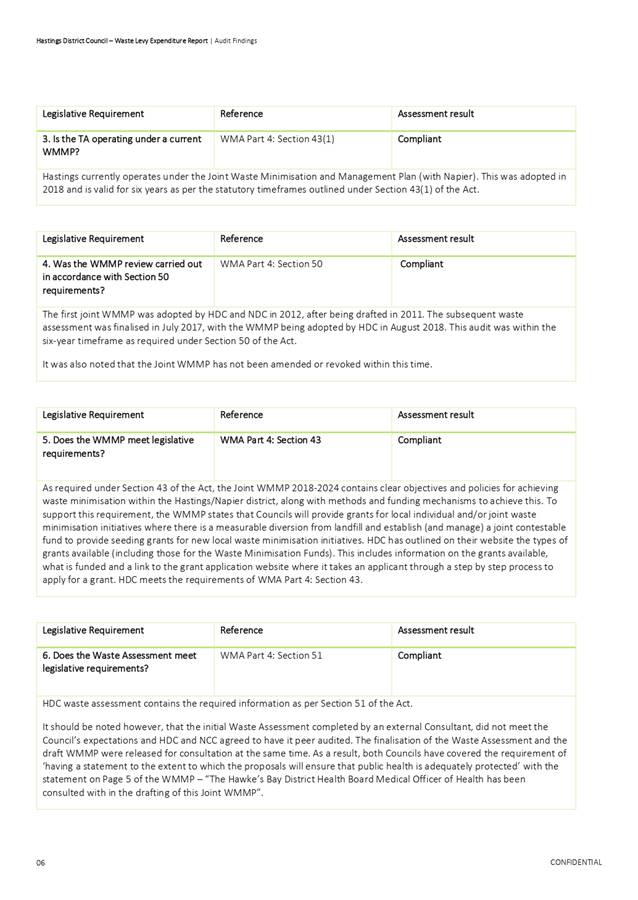





|
Item 6 Hastings District
Council - Waste Management and Minimisation Plan Implementation Update
|
|
WMMP
Implementation Progress Report - March 2021
|
Attachment 2
|


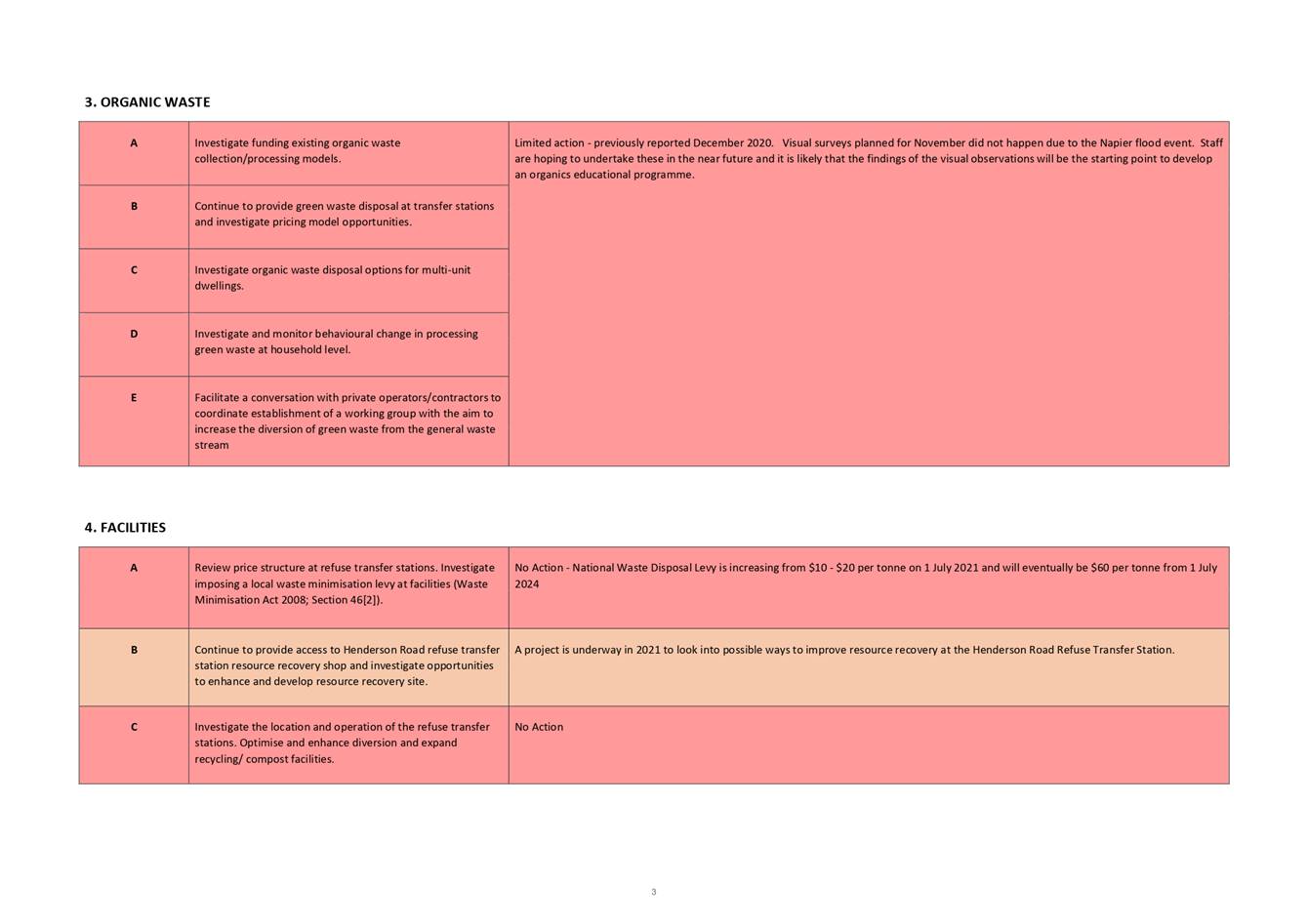


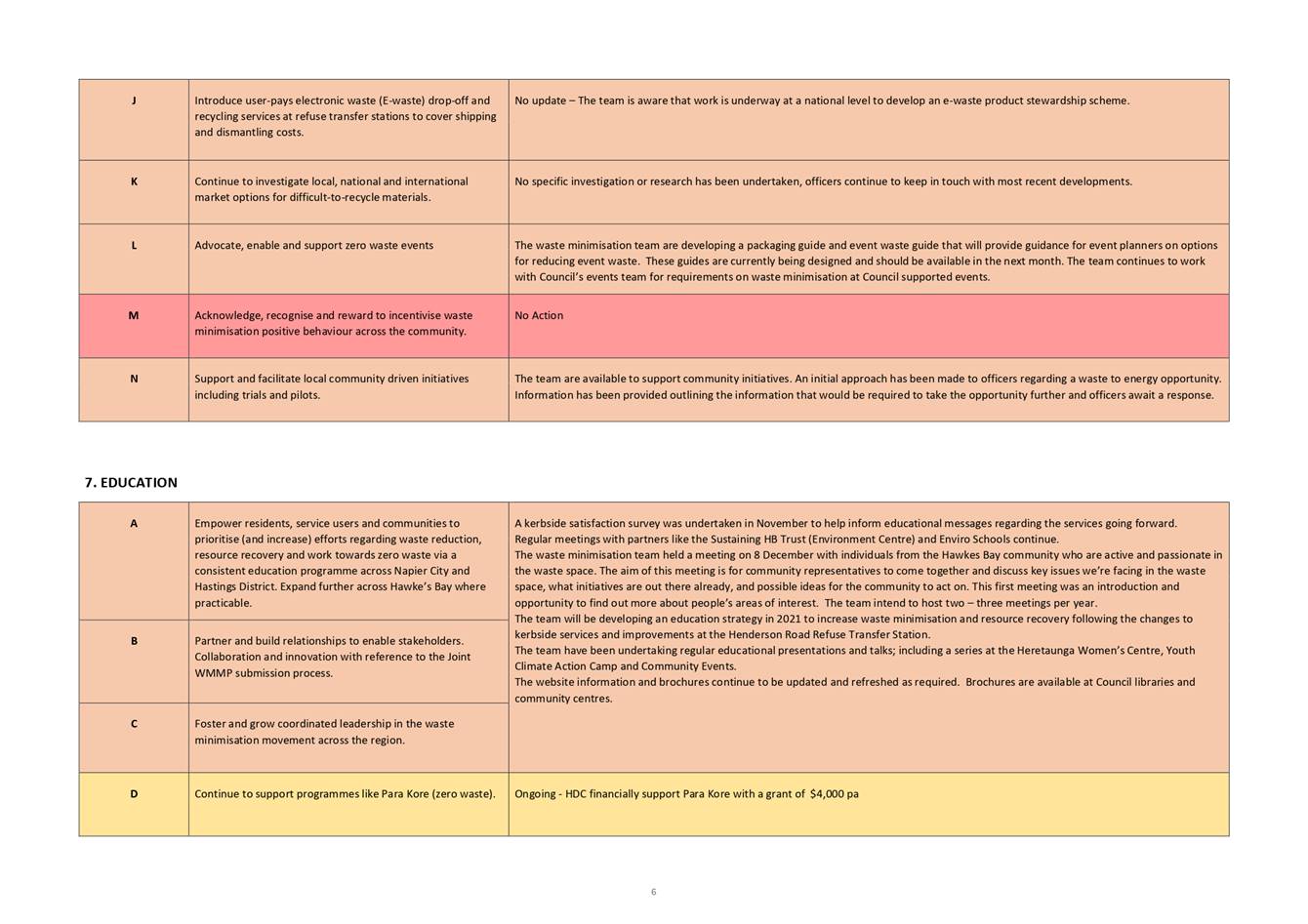
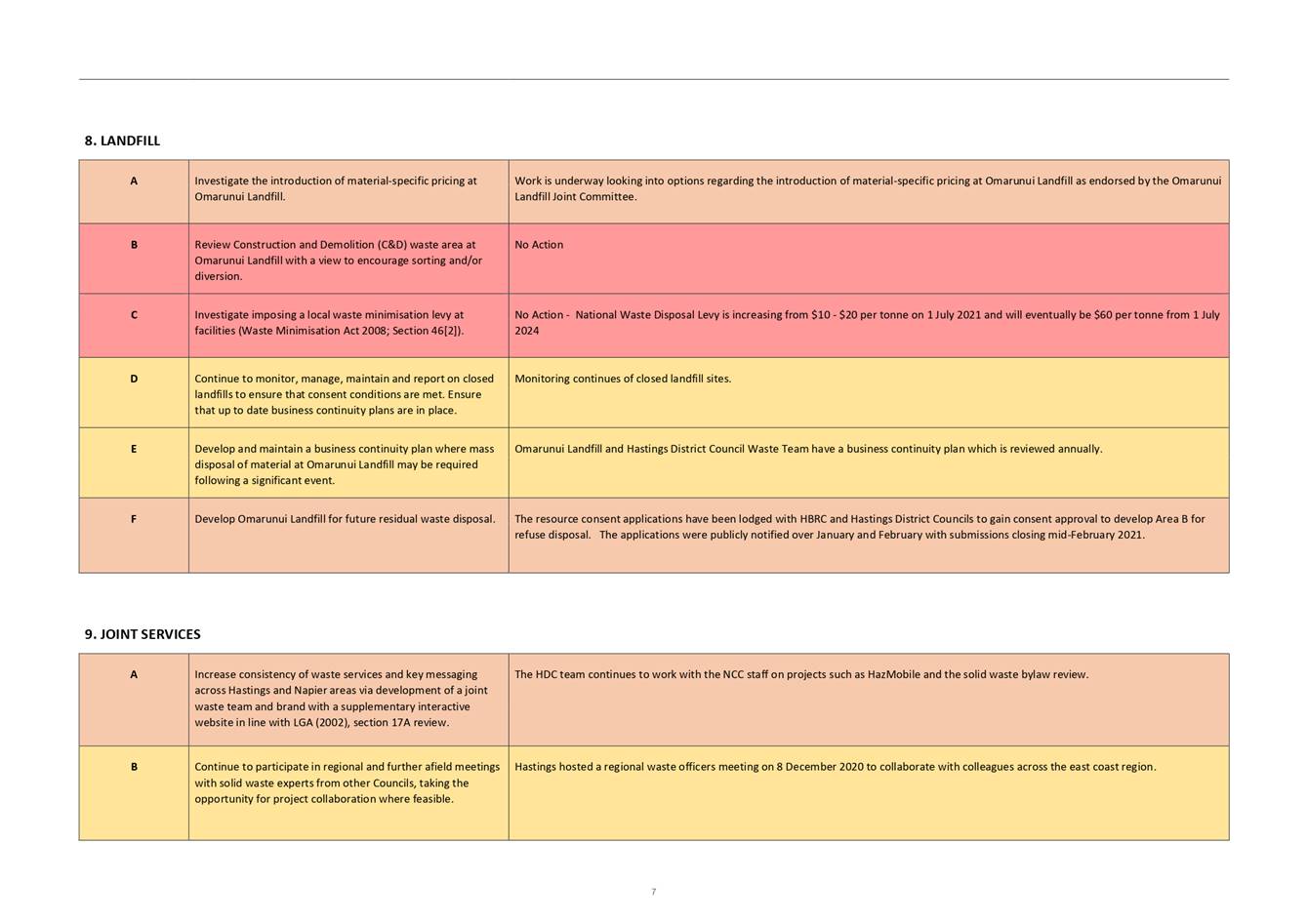
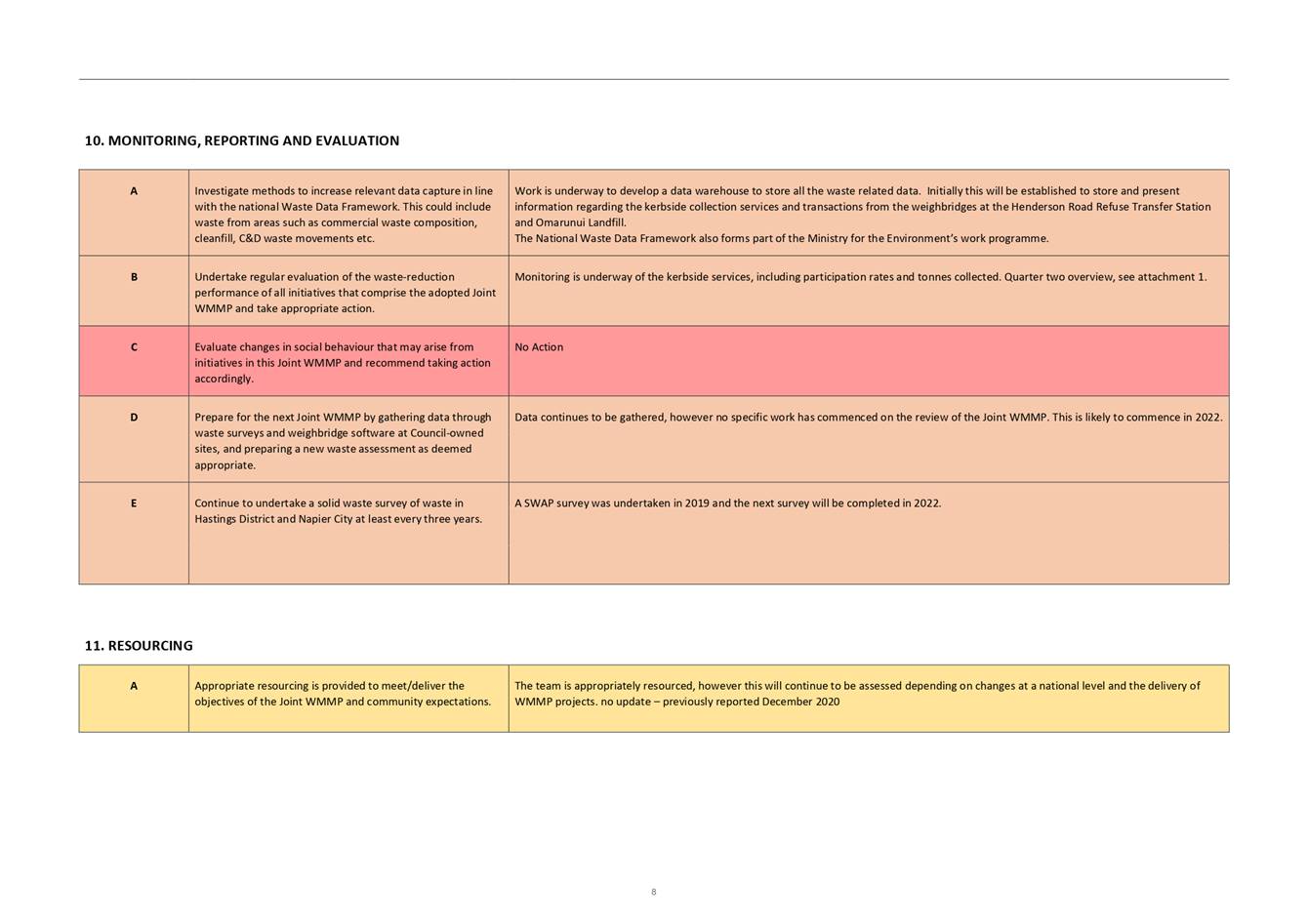
|
Item 6 Hastings District
Council - Waste Management and Minimisation Plan Implementation Update
|
|
Quarterly
Kerbside Services Update Infographic - Oct to Dec 2020
|
Attachment 3
|
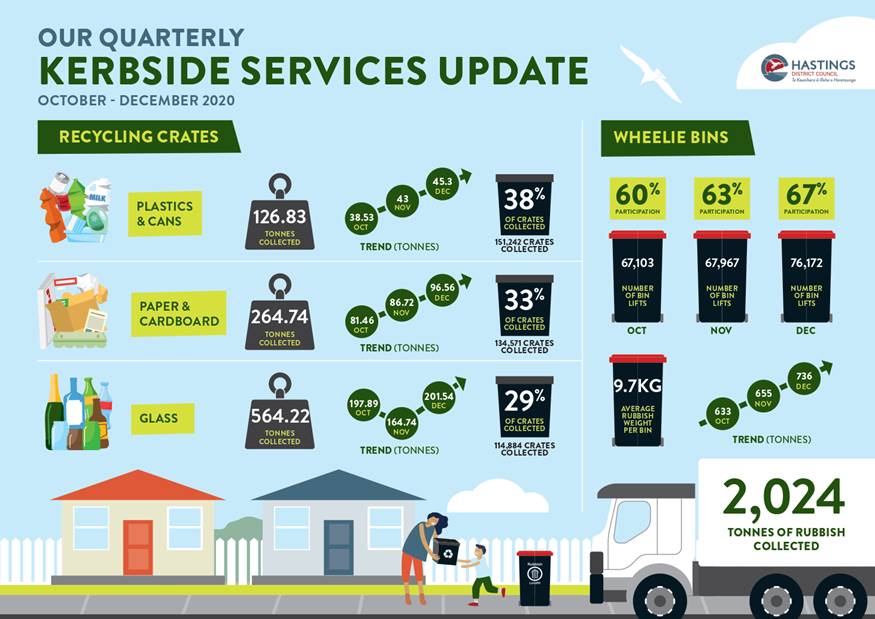
|
Item 6 Hastings
District Council - Waste Management and Minimisation Plan Implementation
Update
|
|
Refuse and
Recycling Kerbside Services - November 2020 Online Survey Results Infographic
|
Attachment 4
|
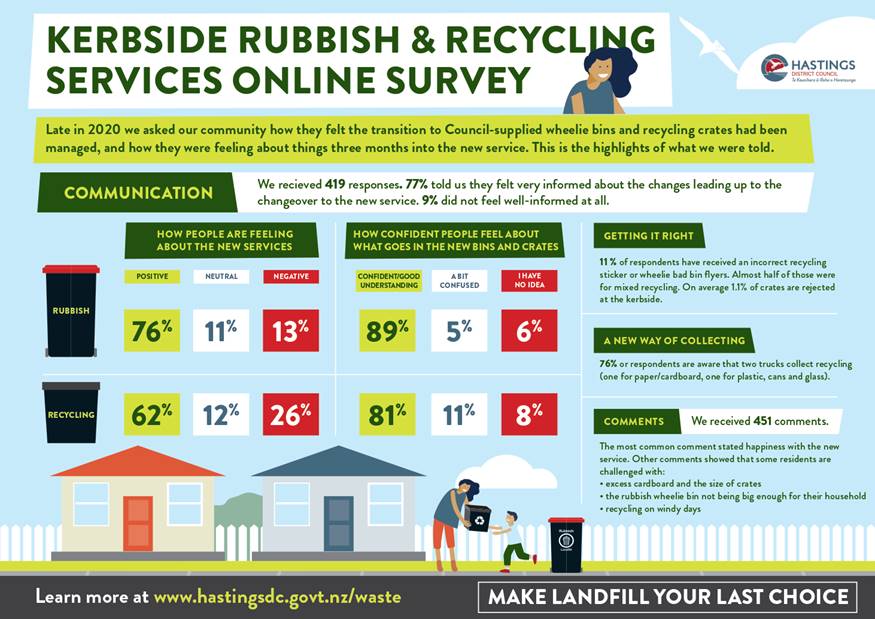
Hastings
District Council: Joint Waste Futures Project Steering Committee
Te Rārangi Take
Report to Joint Waste Futures Project Steering Committee
|
Nā:
From:
|
Angela Atkins, Waste
Planning Manager
|
|
Te Take:
Subject:
|
Local Government Waste
Manifesto - 2020
|
1.0 Purpose and summary - Te Kaupapa Me Te Whakarāpopototanga
1.1 The purpose of this
report to share with the Joint Waste Futures Project Steering Committee the
updated version of the Local Government Waste Manifesto 2020 (Attachment 1).
1.2 The Manifesto outlines
the actions that Central Government needs to take to reduce waste to landfill.
The updated Manifesto summarises the impacts of China National Sword and COVID
19 on the recycling sector, summarises progress made to date on the 5 key
actions called for in the original manifesto and identifies 3 new actions for the
government to progress. These three new actions are:
· Invest
in onshore and local infrastructure for processing of recovered materials
– in particular plastics, paper, organics and building materials
· Standardise
household rubbish and recycling collection systems to improve the quality of
material collected and the materials that are collected.
· Phase
out the use of hard to recycle plastics and initiate a compulsory national
label for recyclability on packaging.
1.3 The 2018 version of
the manifesto and covering memo to the mayor are attached as additional
background information.
|
2.0 Recommendations – Ngā Tūtohunga
A) That the
Joint Waste Futures Project Steering Committee receive the report titled Local
Government Waste Manifesto - 2020 dated 26 March 2021.
|
Attachments:
|
1⇩
|
Local Government Waste Manifesto 2020
|
SW-29-2-20-1
|
|
|
2⇩
|
Local Government Waste Manifesto 2018
|
SW-25-18-4452
|
|
|
3⇩
|
Support for the Local Government Waste Manifesto as a LGNZ
remit, Memo to Mayor, May 2018
|
SW-25-18-4451
|
|
|
Item 7 Local
Government Waste Manifesto - 2020
|
|
Local
Government Waste Manifesto 2020
|
Attachment 1
|
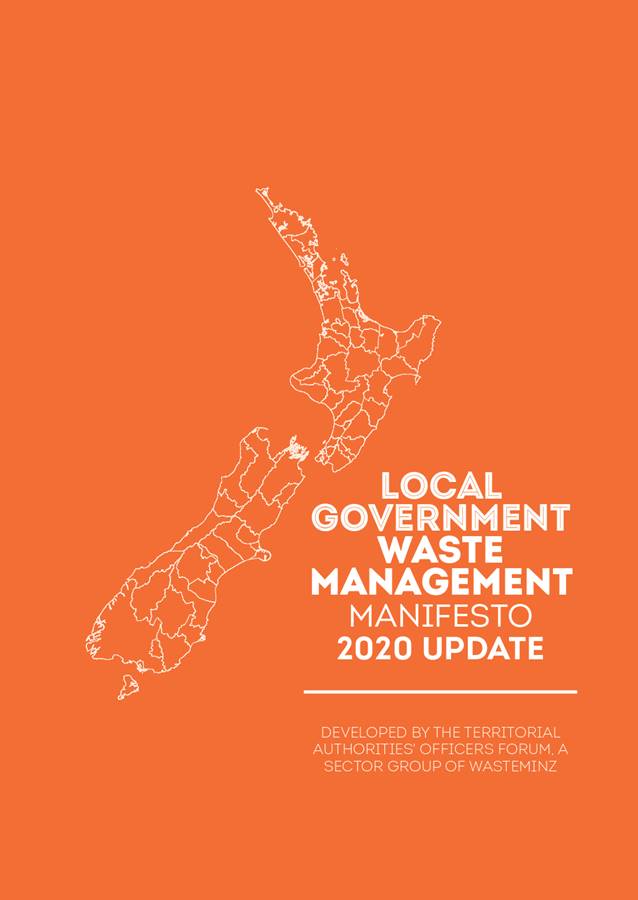
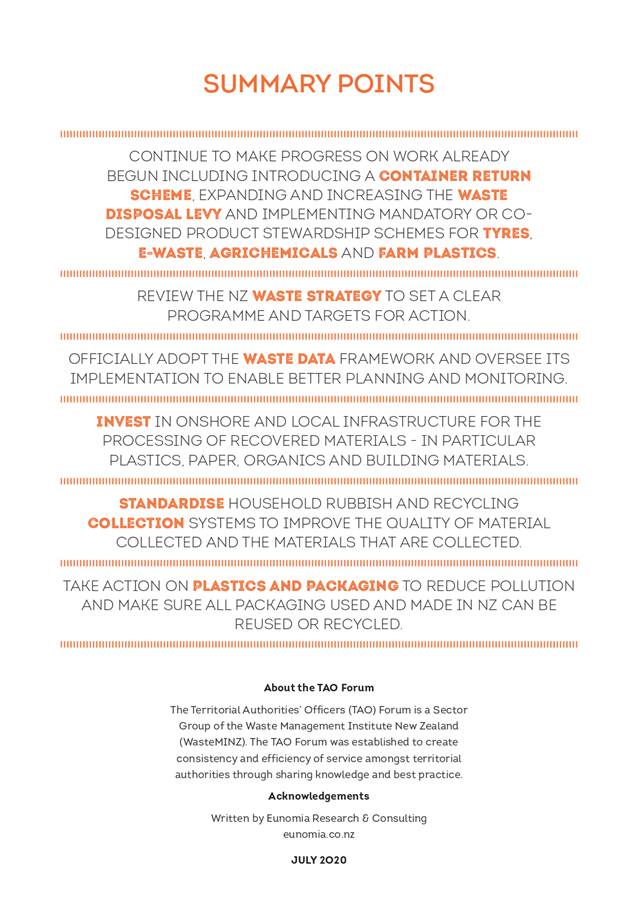

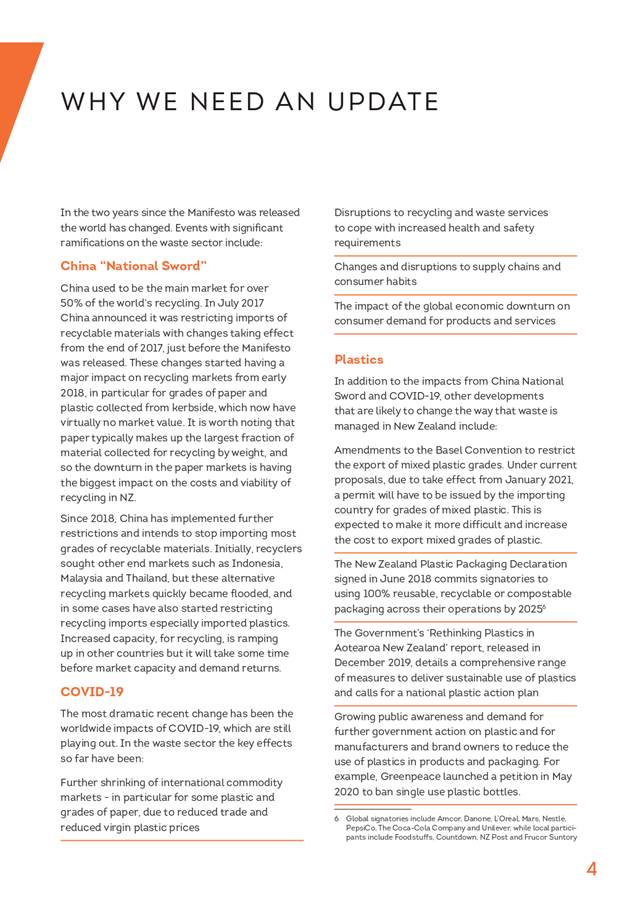
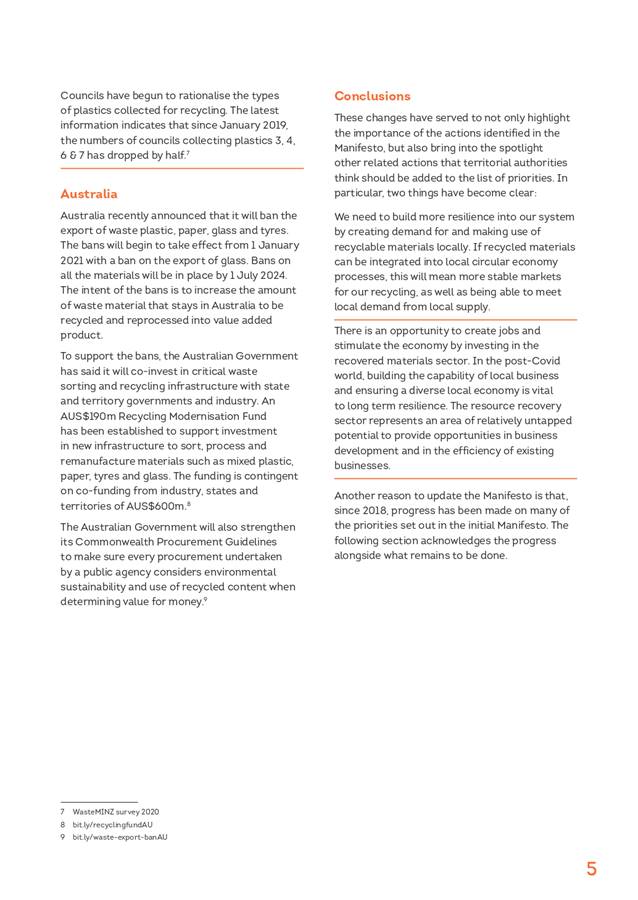
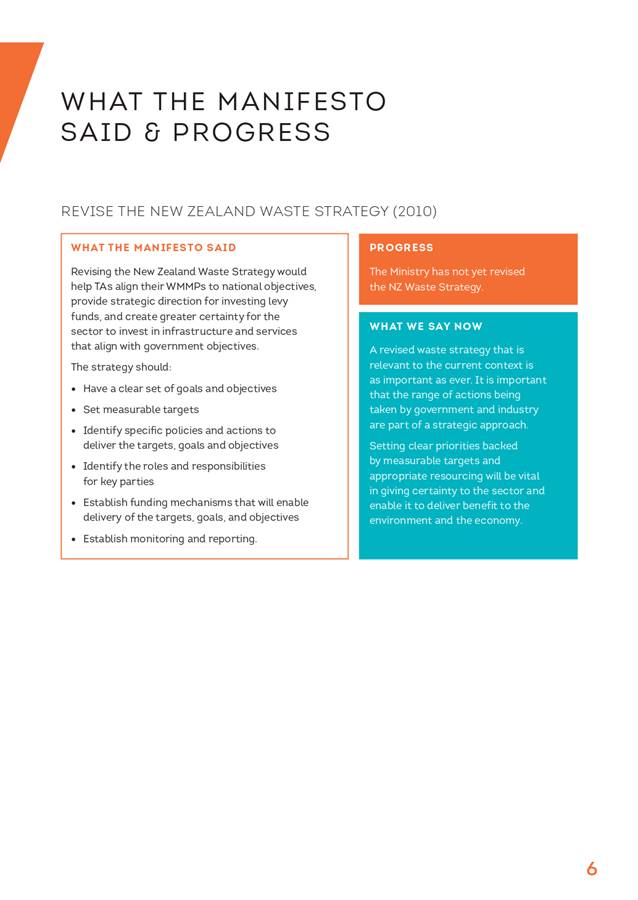
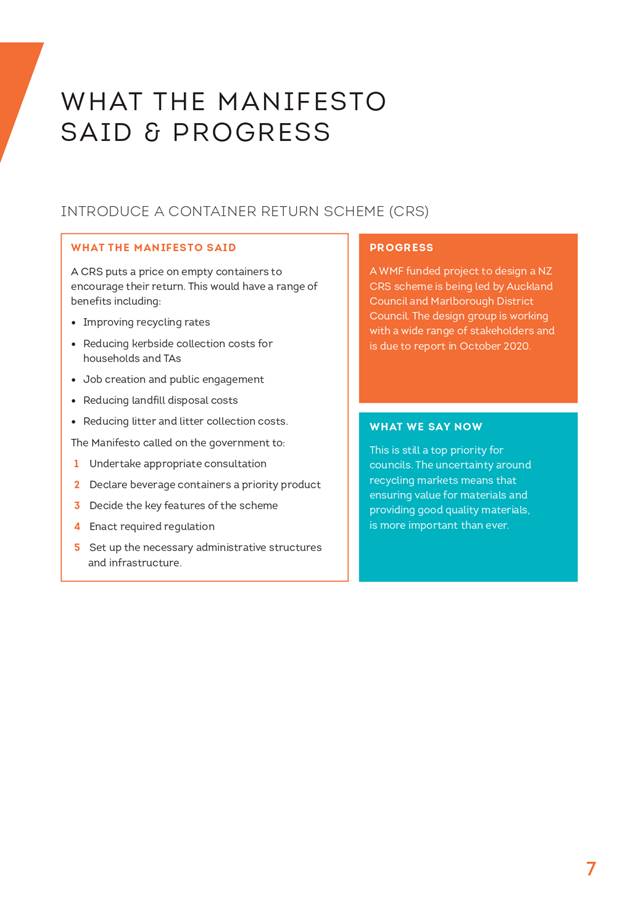
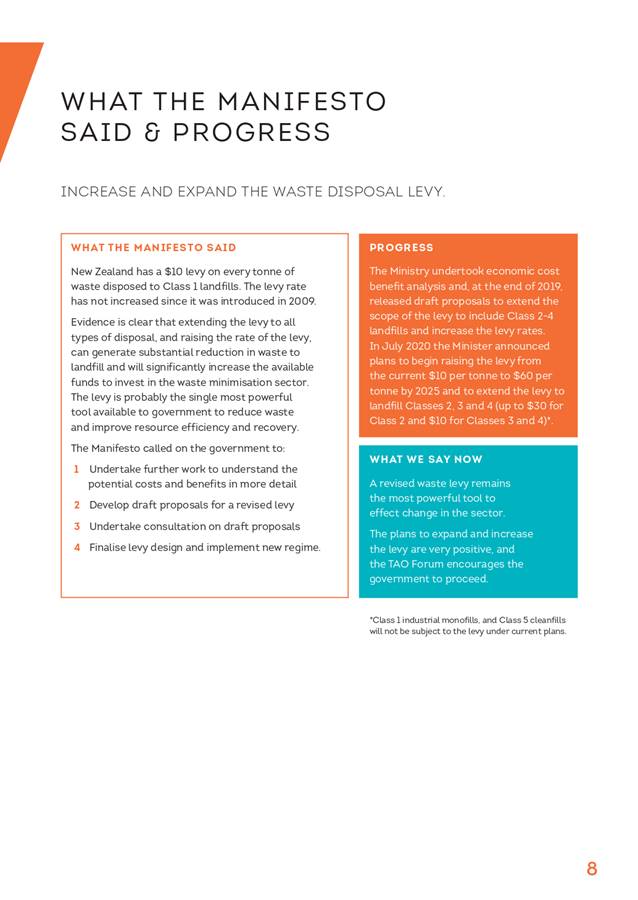
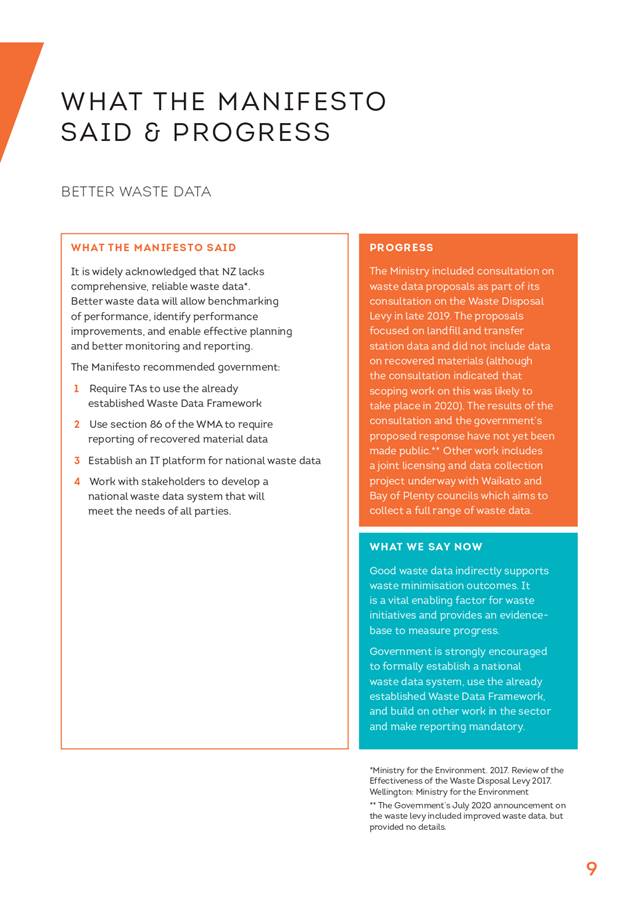
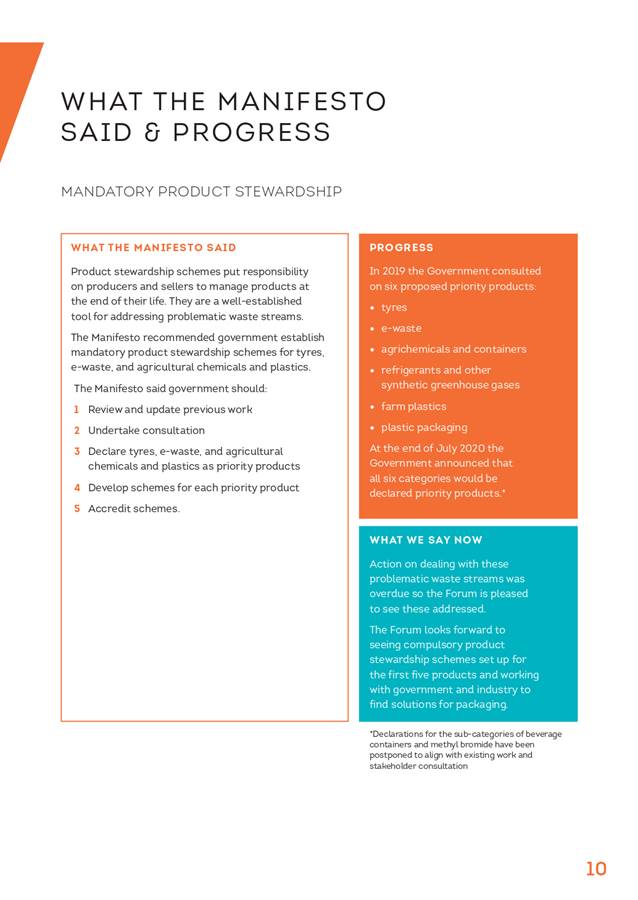
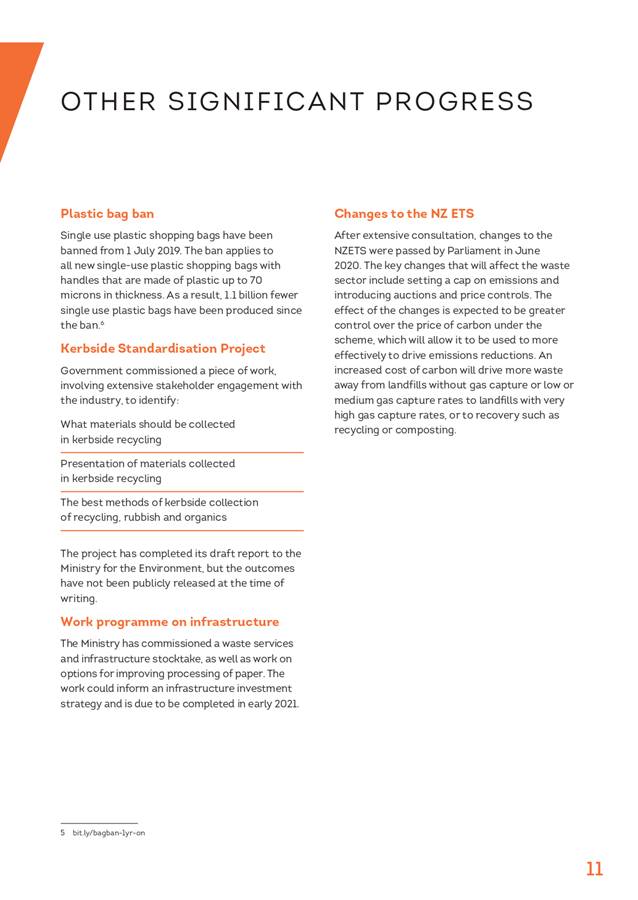
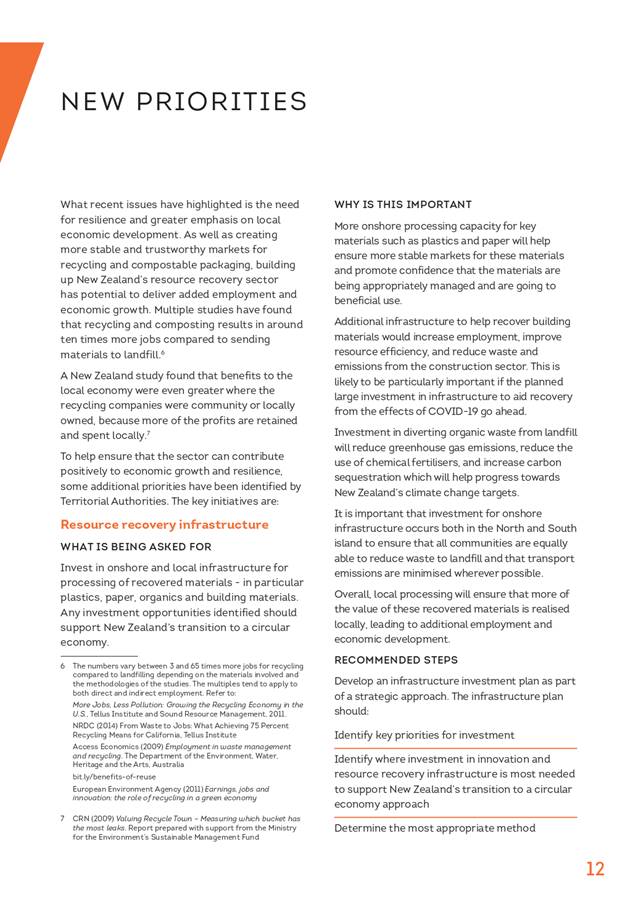
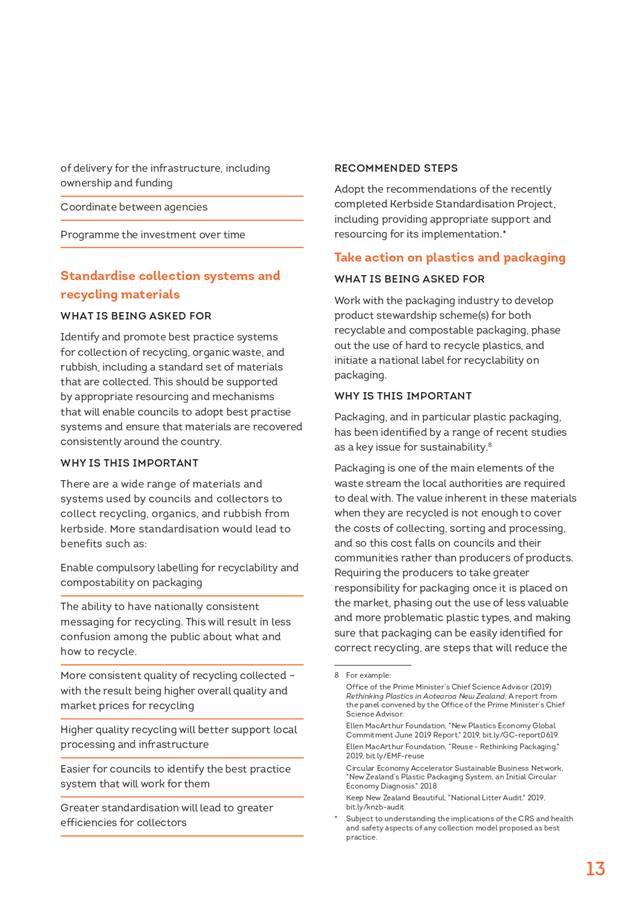
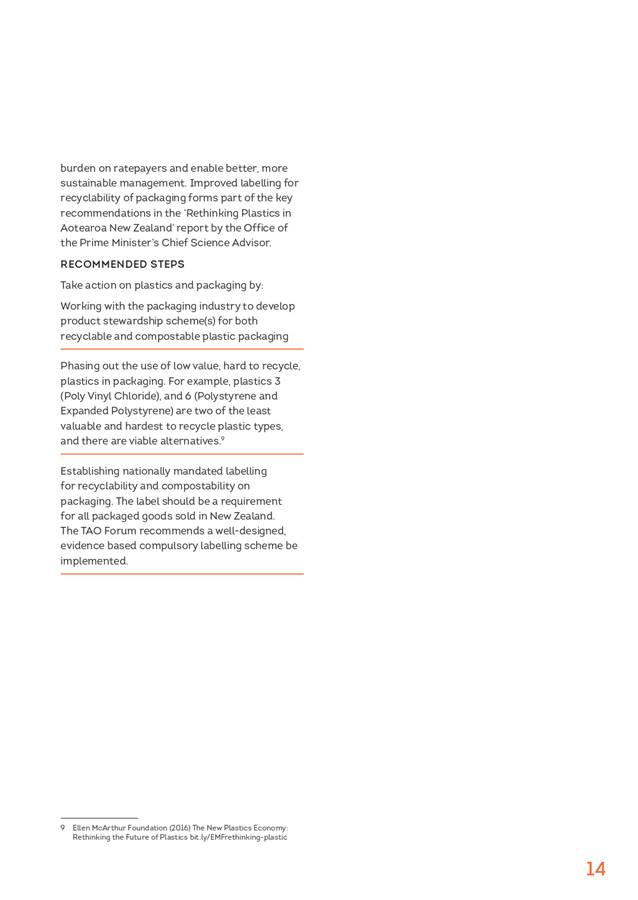
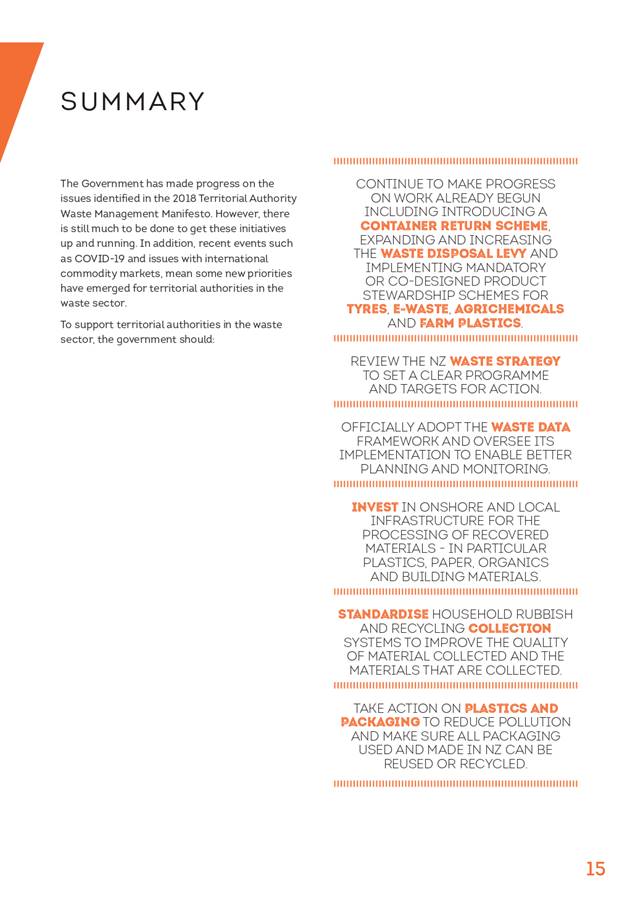
|
Item 7 Local Government
Waste Manifesto - 2020
|
|
Local
Government Waste Manifesto 2018
|
Attachment 2
|
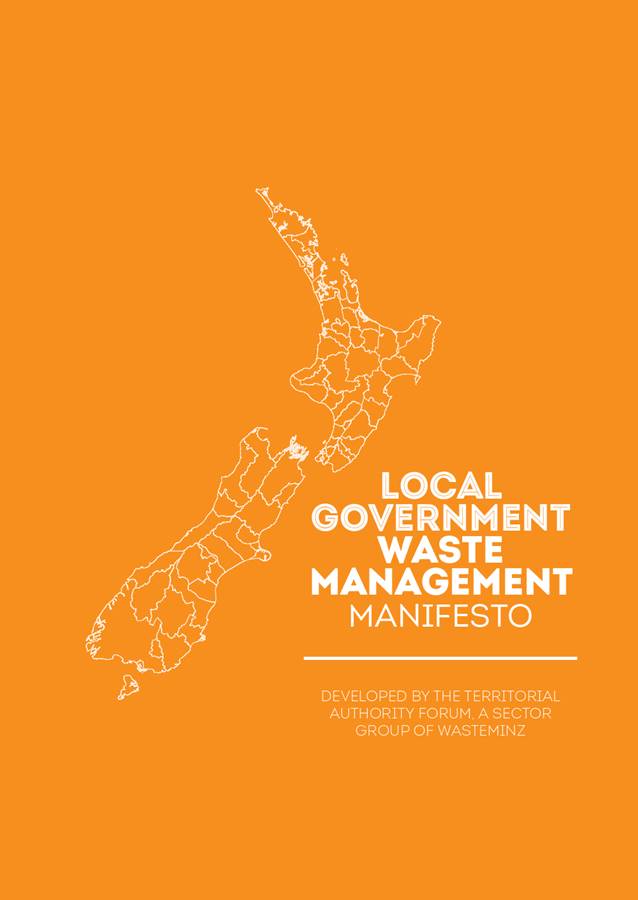
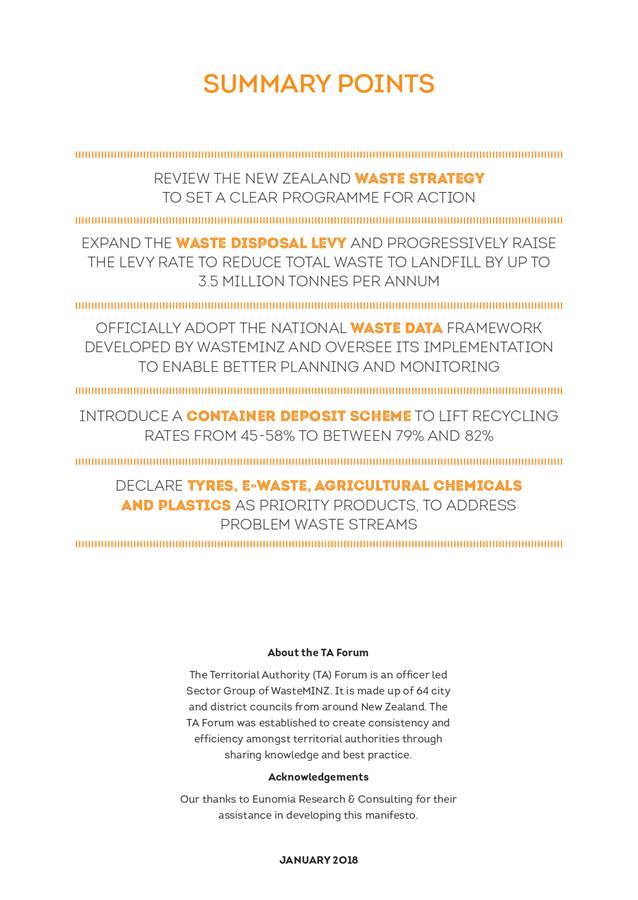

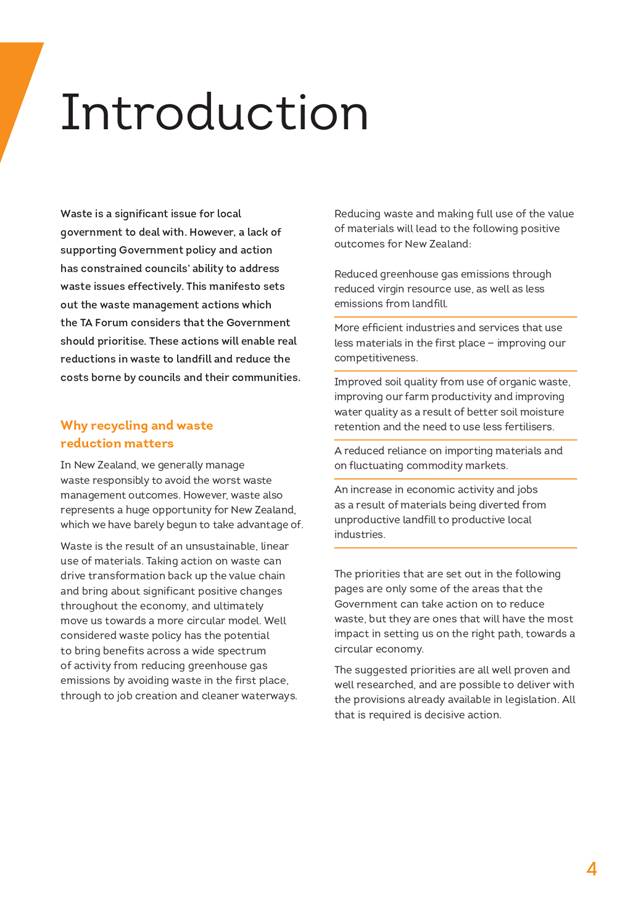
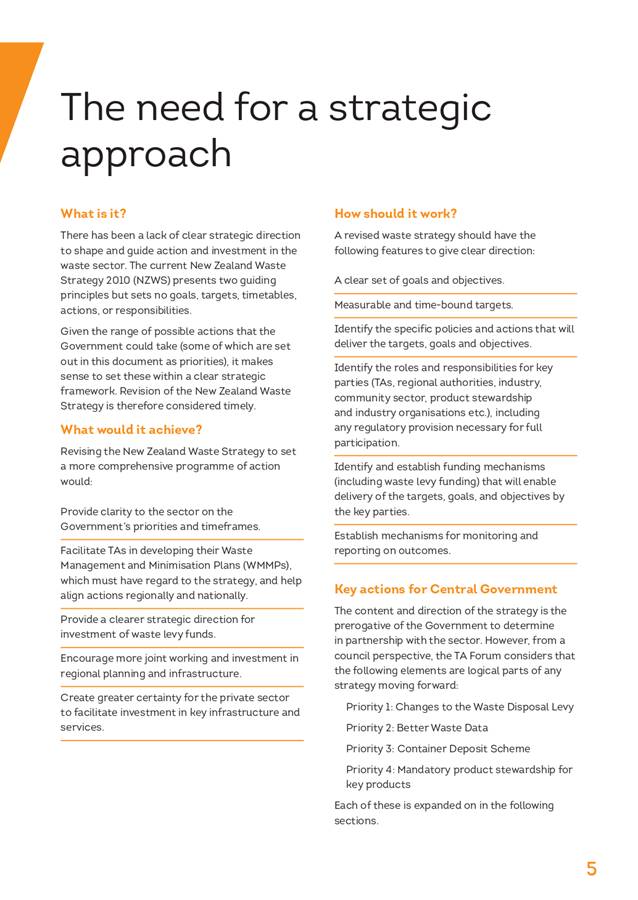
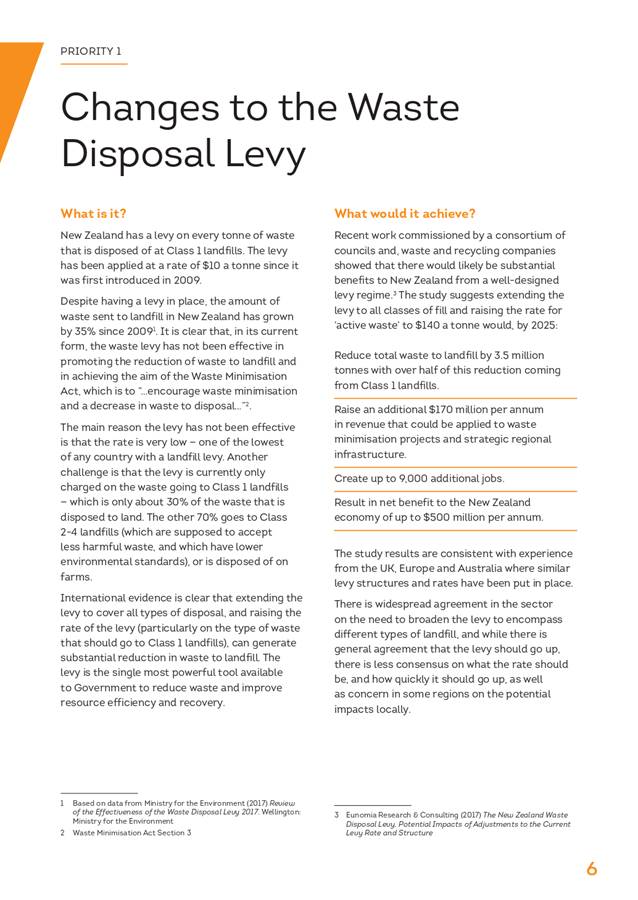
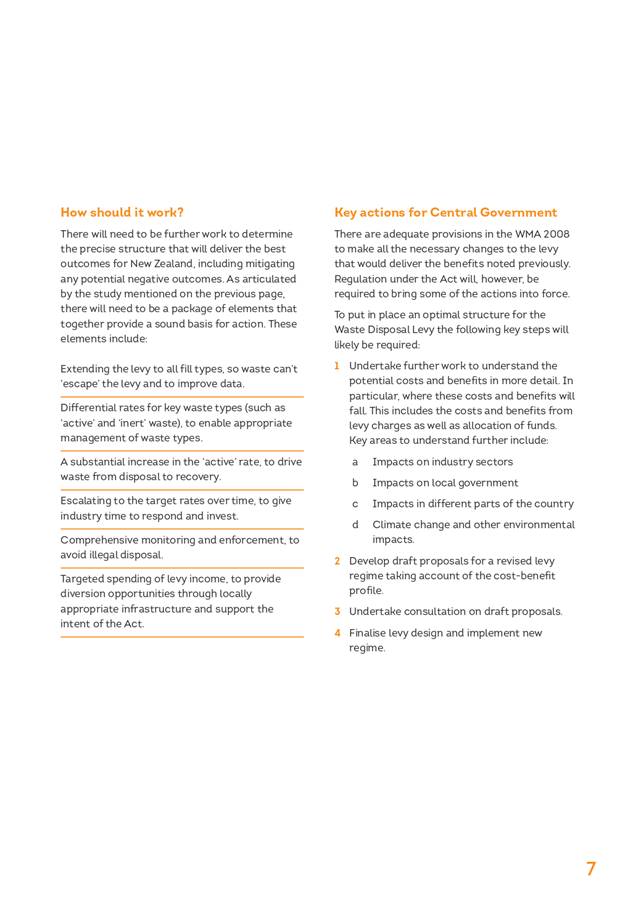
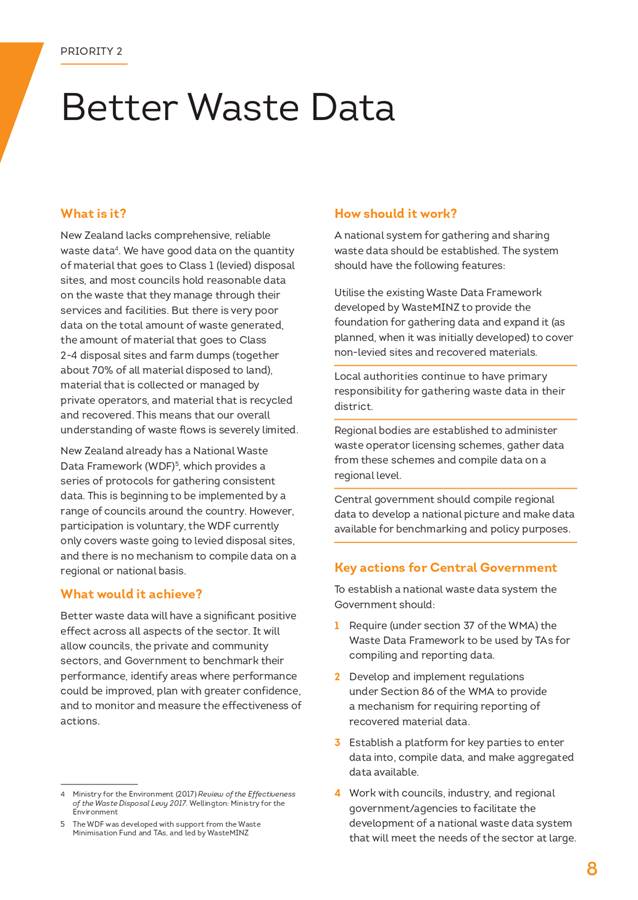
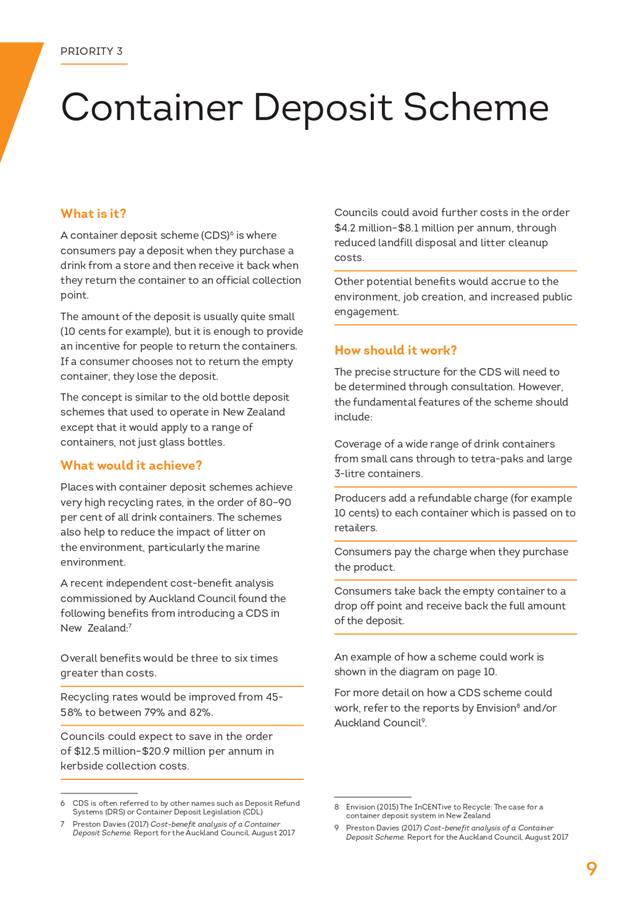
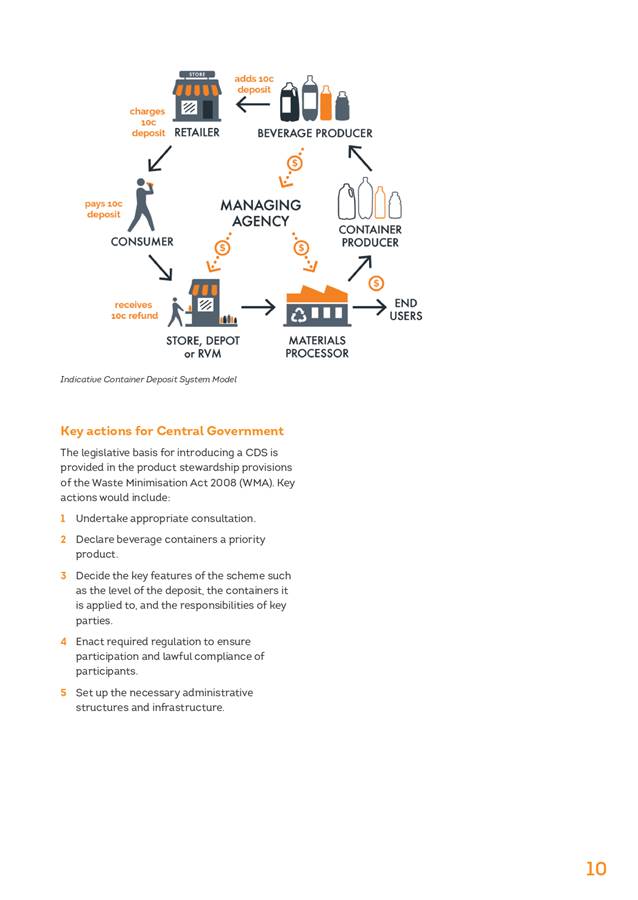
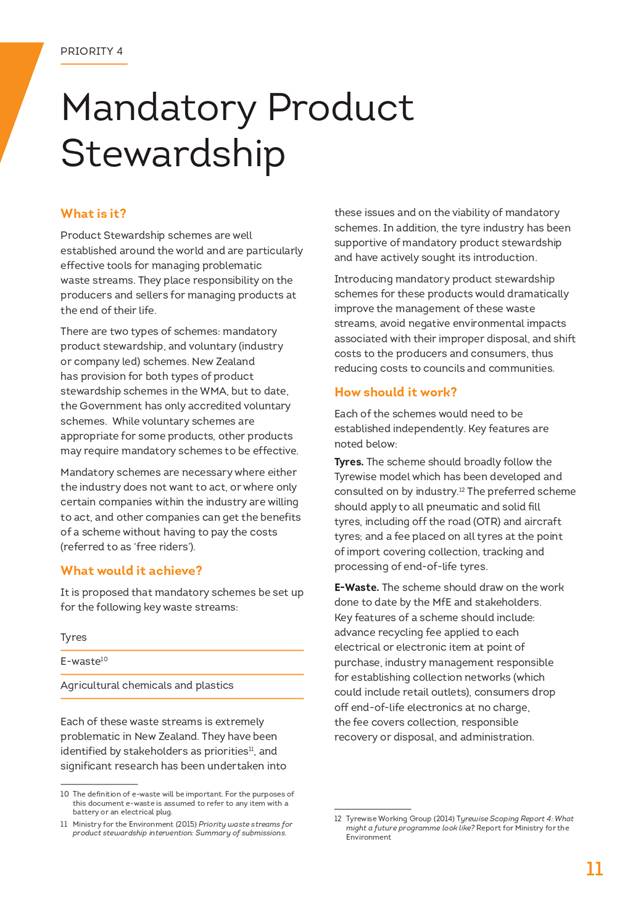
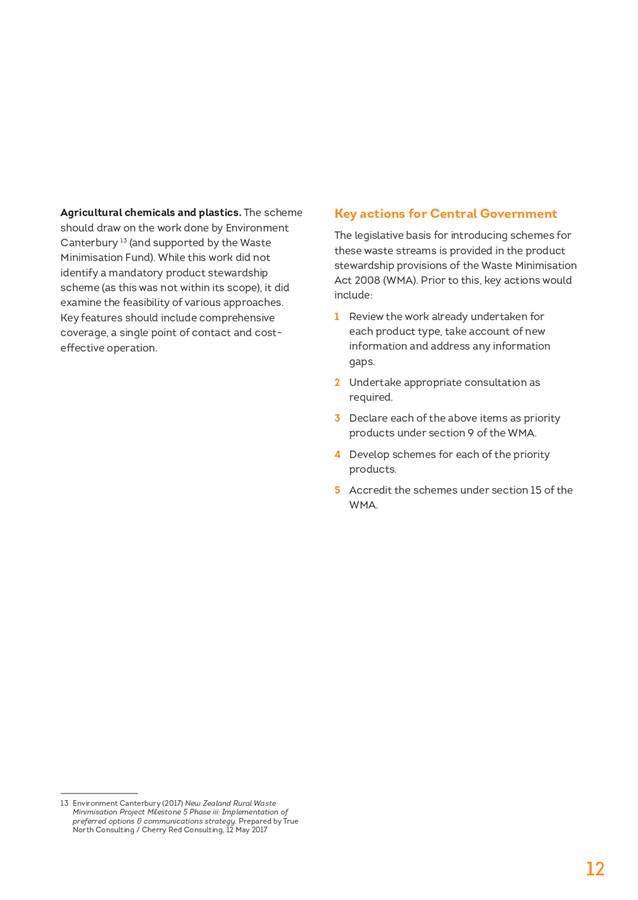
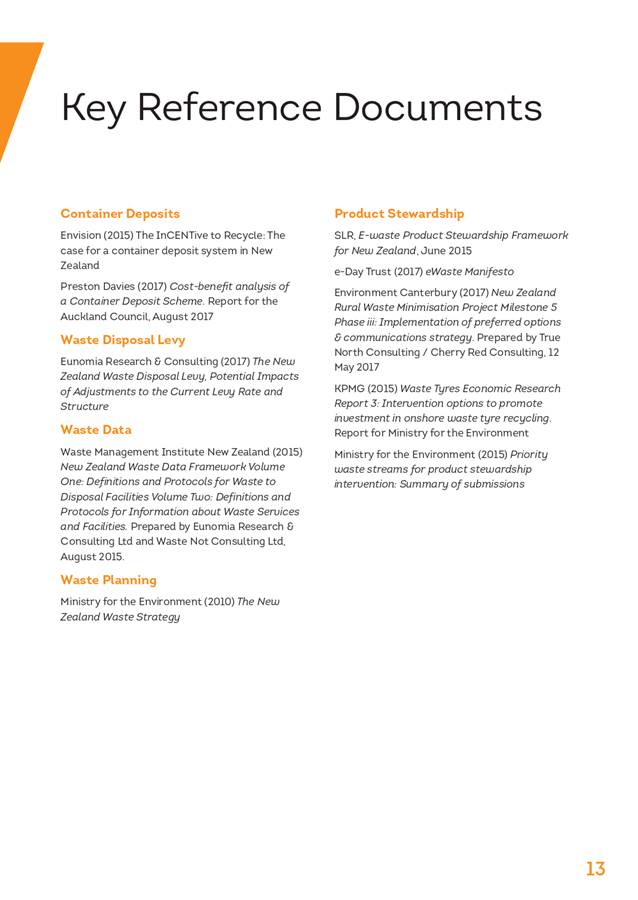
|
Item 7 Local Government
Waste Manifesto - 2020
|
|
Support
for the Local Government Waste Manifesto as a LGNZ remit, Memo to Mayor, May
2018
|
Attachment 3
|
·
MEMORANDUM
File Ref SW-25-18-4451
To: Mayor Sandra Hazelhurst
From: Angela
Atkins
Copy
to: Deputy Mayor Tania Kerr
Date: 8 May 2018
Subject: Support for the Local Government Waste
Manifesto as a LGNZ remit
·
·
·
_________________________________________________________________________________
Summary
· The
Local Government Waste Manifesto (Waste Manifesto) (Attachment
1) identifies five key strategic Central Government actions essential for
improved outcomes in waste management and minimisation in New Zealand.
· The Waste
Manifesto work programme priorities were agreed to by the WasteMINZ TA
forum (territorial authority waste officers), via vote at the annual forum
meeting in November 2017.
· The WasteMINZ TA
forum is now seeking political support for the Waste Manifesto. To this
end Mayor Lester from Wellington City Council is proposing that the Waste
Manifesto be adopted as an LGNZ remit at the LGNZ AGM in July.
· The Zone 4 sector
group in Wellington has agreed to support and nominate the remit and it is
currently with the remit screening committee for approval.
· The Waste
Manifesto contains two actions that have already secured a LGNZ remit,
including a New Zealand Container Deposit Scheme, and a Product Stewardship
scheme for ewaste. The additional components of the Waste Manifesto
proposal includes:
o Review of the New Zealand
Waste Strategy (NZWS) – currently there is no clear strategic
direction, no national targets or timelines, which limits confidence for
investment in the sector.
o Implementation of the National
Waste Data Framework (NWDF) - as developed by the sector in partnership
with MfE - the OECD still regularly reports New Zealand as “one of the
worst” with 0% recycling and 100% waste. While this is not correct, New
Zealand has not been collecting sufficient data for the OECD to report
otherwise. Improved data would also enable TAs to plan more effectively, as
well as measuring and monitoring performance.
o Application of the waste levy
to all landfill types, and then, subject to further work, increase the levy -
the former alone could generate as much as $100M in levy funds. Based on the
current TA levy allocation (50%), extending the levy to all landfill types
would create a significant increase in the levy revenue for Council spending on
waste management and minimisation activities (currently the levy brings in $35 million
per year across New Zealand).
o Establish product stewardship
schemes for tyres, agricultural chemicals and agricultural plastics. The tyre
industry has helped to develop Tyrewise, a tyre product stewardship
scheme. All that remains is to implement the scheme, and it has industry
support to do so. As farms dumps are a permitted activity for many Councils,
waste agricultural chemicals and plastics will continue to contaminate the
environment when burnt and buried unless farmers are supported and enabled by
the appropriate product stewardship schemes.
· All of the
proposed waste manifesto actions exist within the scope of the Central
Government provisions available in the Waste Minimisation Act (2008).
Ministerial media announcements and Council officer discussions with Ministry
officers suggest the waste manifesto may be timely.
Background
The Local Government Waste Manifesto
(Attachment 1) was developed by the Territorial Authority Forum (TA Forum)
sector group of the Waste Management Institute of New Zealand (WasteMINZ). The
sector group is made up of waste officers from 64 city and district councils
from around New Zealand. The purpose of the sector group is to create
consistency and efficiency for territorial authorities through sharing knowledge
and best practice for waste management and minimisation.
Waste is a significant issue for local government
to deal with and the tools and policy levers local government has are limited.
Consequently, the most efficient solutions to issues discussed at the TA Forum
often come back to the need for Central Government policy and action. New
Zealand is some 10-20 years behind many other developed nations in the
application of waste management and minimisation policy. This national
situation has constrained councils’ ability to address waste issues
effectively. One advantage to this is that many policy solutions have now been
tried and tested by other countries, which puts New Zealand in a position where
it can adapt and adopt those that work well.
What is in the Waste Manifesto?
The Waste Manifesto provides a concise
list of strategic Central Government policy actions necessary for a real
reduction in waste to landfill, and enhanced environmental outcomes in New
Zealand. The key priorities of the Waste Manifesto include:
Priority 1: The need for a strategic approach
– the current lack of a strategic direction for waste in New Zealand has
led to limited action and investment in the waste sector. A revision of the New
Zealand Waste Strategy (2010) with clear goals and objectives, along with
measurable and time bound targets would encourage joined up local, regional,
and national planning. Strategic planning at all tiers would in turn provide a
clear direction and give confidence for the investment of private sector and
waste levy funds.
Priority 2: Changes to the waste disposal levy
– New Zealand’s waste disposal levy was introduced in 2009, it has
remained at $10 per tonne since. Meanwhile, waste disposal nationally has
increased by 35% over the same time frame. The levy is also only applied to
about 30% of all waste (i.e. Class 1 landfills only). Currently the levy brings
in around $35 million per annum, of which half is returned to TAs for spending
in accordance with their WMMP action plans. If the levy was extended to all
landfill types (i.e. including Class 2, 3 and 4 landfills), it would generate
in the order of$100 million (possibly more as tonnage to class 2, 3 and 4
landfills is often based on estimates). Assuming the same model of levy
redistribution (50% to TAs), this would significantly increase TAs ability to
invest in the delivery of their WMMP actions.
Different countries have adopted different levy
rates, structures, and supporting policies to reduce waste. Figure 1 overleaf
depicts the current levy rates for different countries (in NZ $). It can be
observed that most countries have a significantly higher levy rate than NZ,
with UK having the highest of $162 per tonne.
Levy Rates for Active Waste in Different Countries, NZ
$
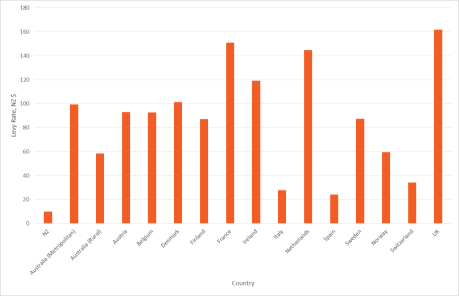
Source: The New
Zealand Waste Disposal Levy, Potential Impacts of adjustments to the current
Levy Rate and Structure (2017)
Increasing the rate of the levy is arguably the
New Zealand government’s most powerful policy tool for driving change
across the entire sector. As has been seen in other countries, changes to the
levy would have impacts on industry, local government, across the different
regions and on greenhouse gas emissions. It is important to note that the Waste
Manifesto advocates for the government to undertake further work on the
effects of raising the levy would be on specific sectors and regions. Following
that work, further consultation is requested on the proposed changes before
implementing any change.
Priority 3: Better Waste Data –
New Zealand currently lacks comprehensive, reliable waste data. As a result the
OECD has recently reported on the international stage that NZ has 0% recycling
and 100% waste. [1]
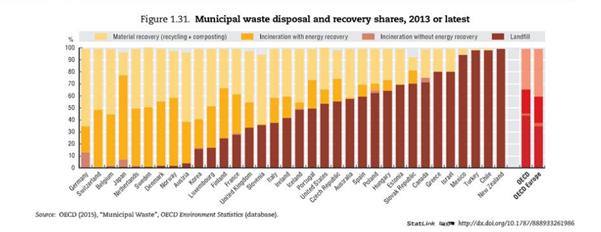
A project led by the sector (through WasteMINZ),
with funding support from the Ministry for the Environment and councils
developed the “National Waste Data Framework” in 2015/16.
Ministry officials are currently considering making waste a tier 1 reporting
requirement with Statistics NZ. As such, the NWDF has the potential to
become mandatory.
Many councils have recognised this waste data
issue within their latest WMMP and are currently working towards the
implementation of the NWDF. Our draft Joint WMMP with NCC contains the
goal to “improve information on waste generation and movements in
Napier and Hastings” with the objective “to work towards
aligned data collection and reporting systems across Hastings District and
Napier City and New Zealand.” Addressing the data issue at the
local, regional and national level will also support better strategic planning
and improve confidence for investment in the sector.
Priority 4: Container
Deposit Scheme – A Container Deposit Scheme (CDS) involves consumers
paying a deposit (e.g. 10 cents) when they purchase a drink from a store, then
receiving their money back when they return the container to an official
collection point. The main purpose of a CDS is litter reduction. A recent study[2] has shown that:
“Where present,
container deposits reduce the amount of beverage containers on the coasts of
both the United States and Australia by 40%. What’s more, the reduction
is even more pronounced in areas of lower socio-economic status, where plastic
waste is most common.”
If all the coastal US
states without CDS were to implement it, there would be an estimated
“…6.6
million fewer containers on the shoreline of the US each year.”
There are multiple other benefits to an NZ CDS[3], these include:
· savings on
kerbside services for NZ Councils of up to $20.9 Million (mainly through fewer
trucks);
· increasing
recycling rates from 45-58% to 79%-82% nationally
· savings to NZ
Councils of up to $8.1 Million through reduced disposal and litter clean-up
costs
· other benefits
including job creation and increased public engagement
An important open question relating to a NZ CDS
is “where would the public drop their drink containers?” In other
countries this has been addressed through a mix of models including retailer
drop offs, reverse vending machines, and depot drop offs. This level of detail
would be subject to much greater consideration for all stakeholders if the
minister decides to investigate a CDS for NZ. The Waste Manifesto also
advocates for a consultation process so the details can be worked through in a
collaborative way.
Priority 5: Mandatory Product Stewardship –
Product stewardship is widely established around the world; and such schemes
are particularly effective at dealing with problematic waste streams. Broadly
speaking, product stewardship schemes place the responsibility on the producer
and sellers for managing products at the end of their life. The Waste
Manifesto advocates for product stewardship on three problem waste streams
in NZ:
· Ewaste -
This already has an LGNZ remit.
· Tyres - An
industry developed and supported scheme has already been developed (called Tyrewise) but requires Central Government support.
· Agricultural
chemicals and agricultural plastics - As farms dumps are often a permitted
activity (necessitated by practicality), in the absence of product stewardship
schemes, agricultural chemical and plastic wastes will continue to contaminate
the air (when burnt) soils (when buried) and water ways (as farm dump pits are
not required to be lined). Farmers need access to schemes that help them divert
these harmful wastes from farm dumps.
Attachment 1: Local Government Waste Manifesto (SW-25-18-4452)
·

·
Angela
Atkins
Waste Minimisation Officer
·
angelama@hdc.govt.nz
Preston Davies
(2017) Cost-benefit analysis of a
Container Deposit Scheme. Report for
the Auckland Council, August 2017
 Te Hui o Te Kaunihera ā-Rohe o Heretaunga
Te Hui o Te Kaunihera ā-Rohe o Heretaunga




















































